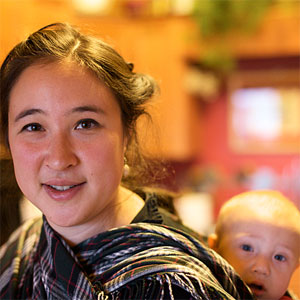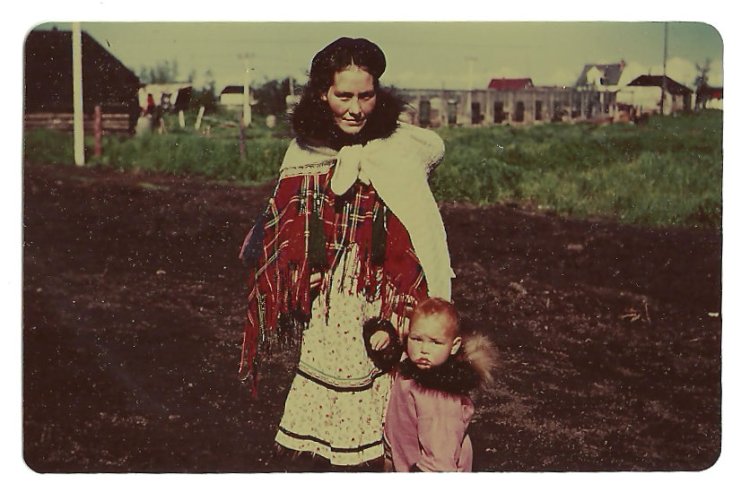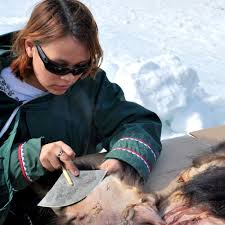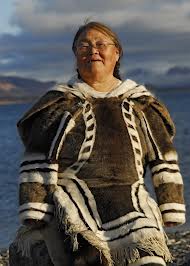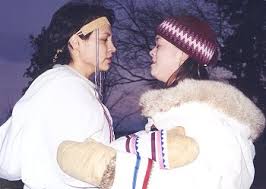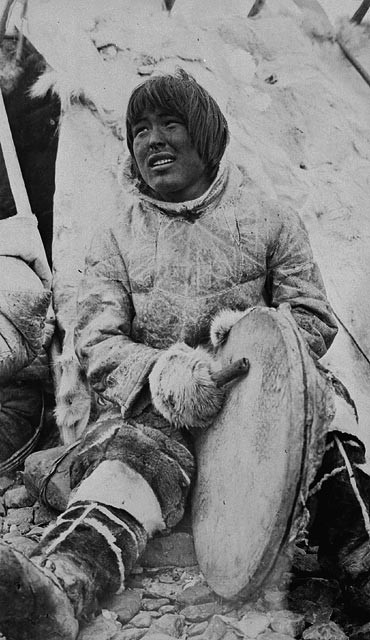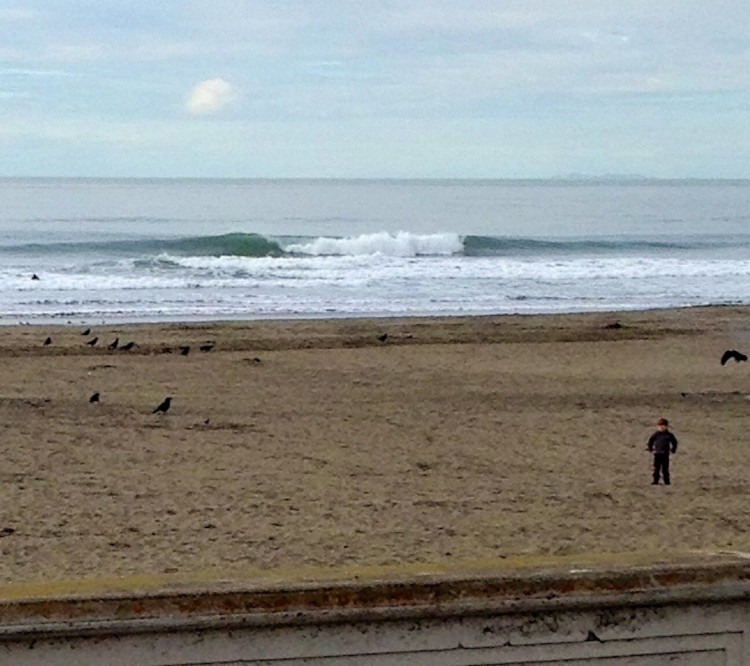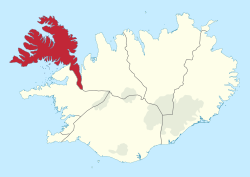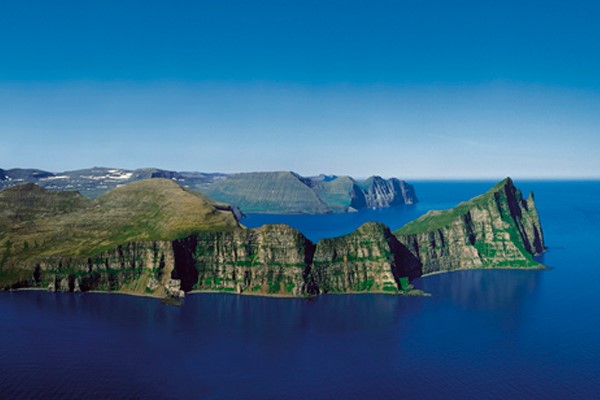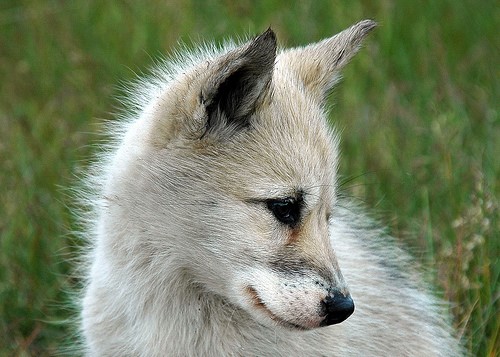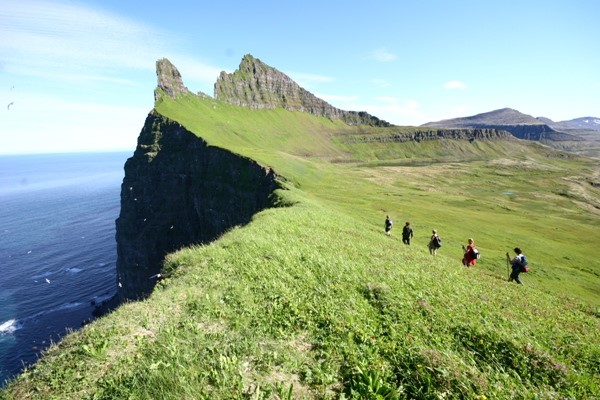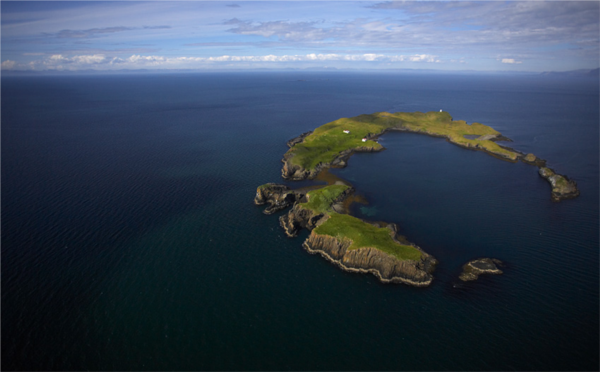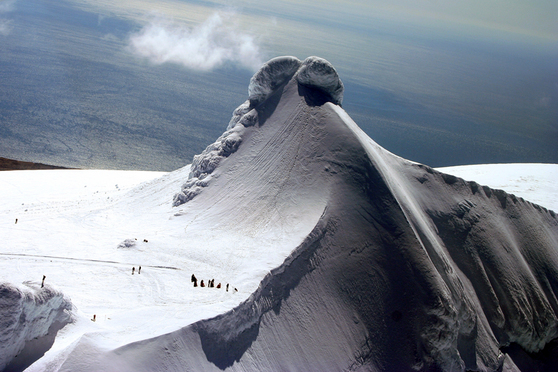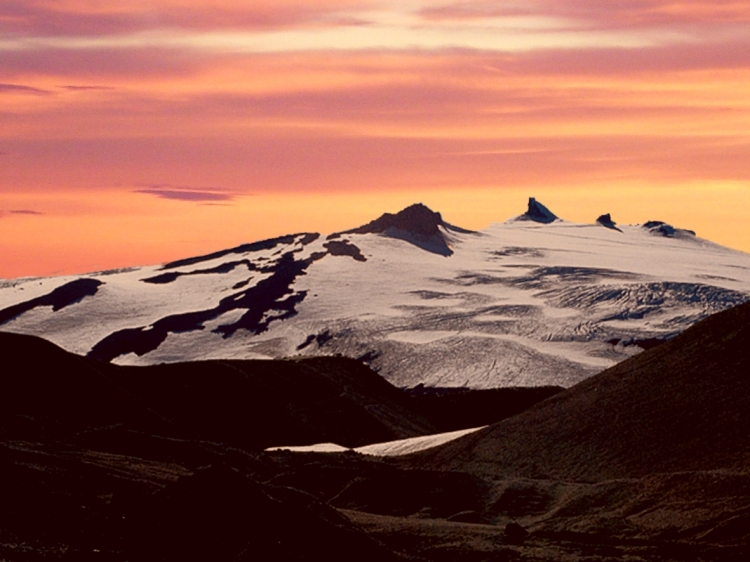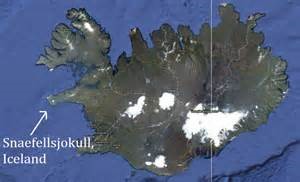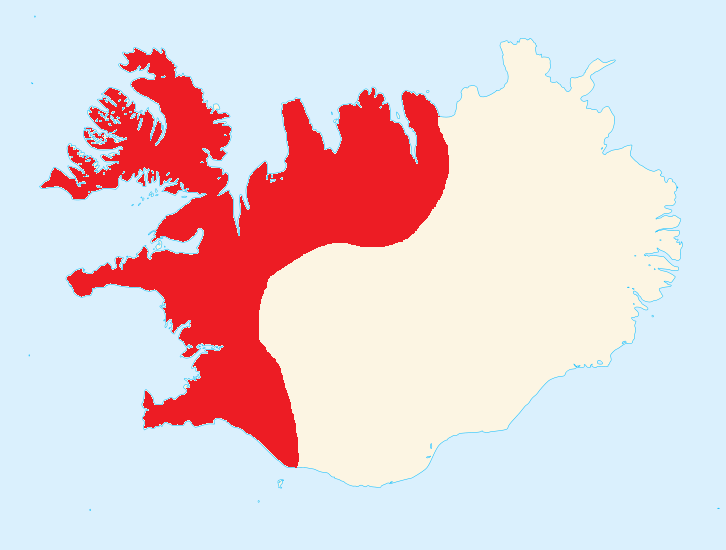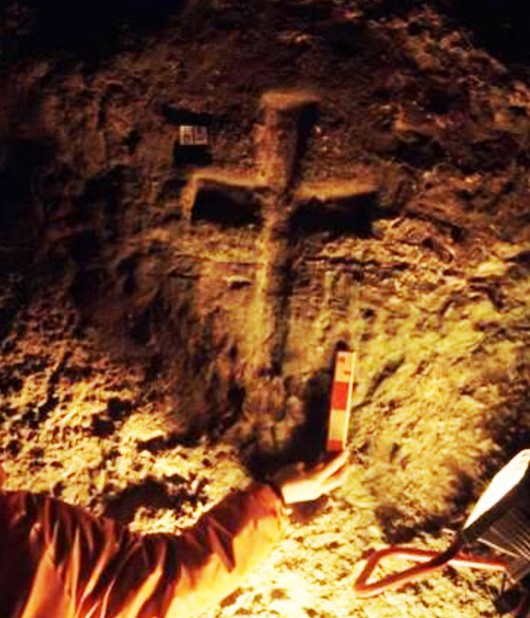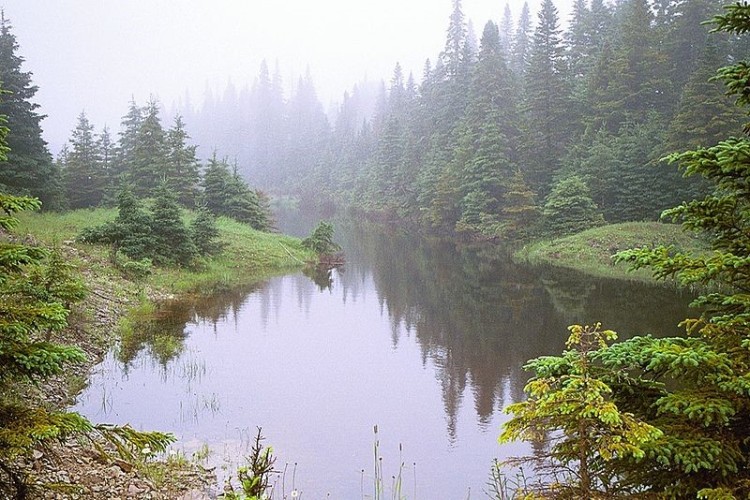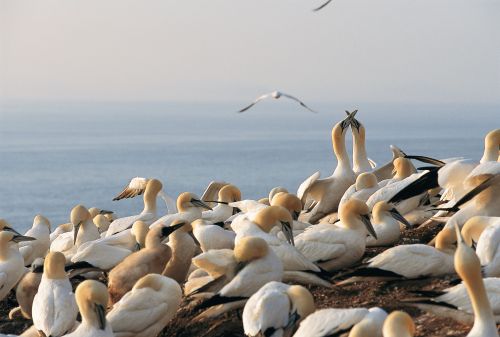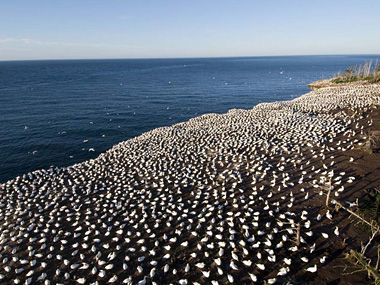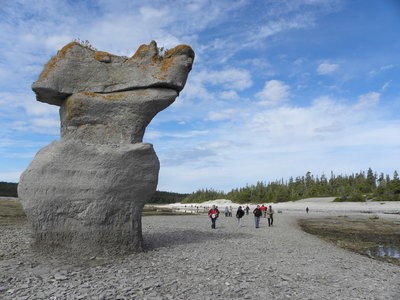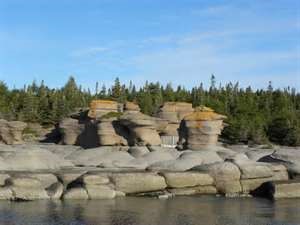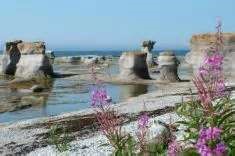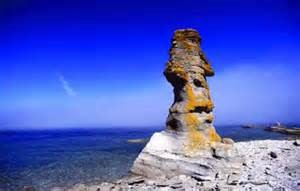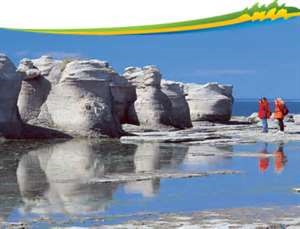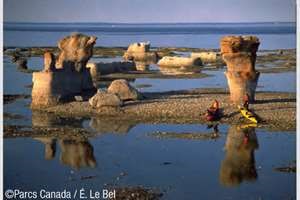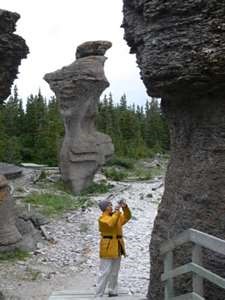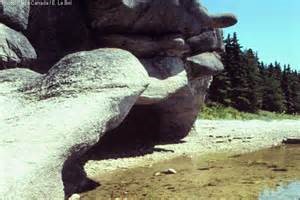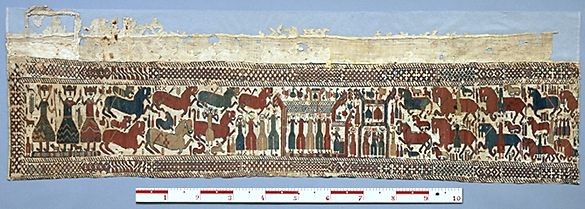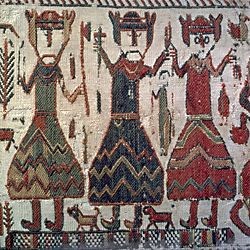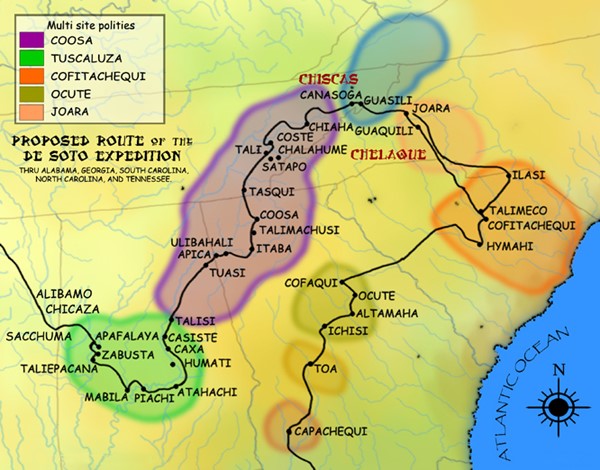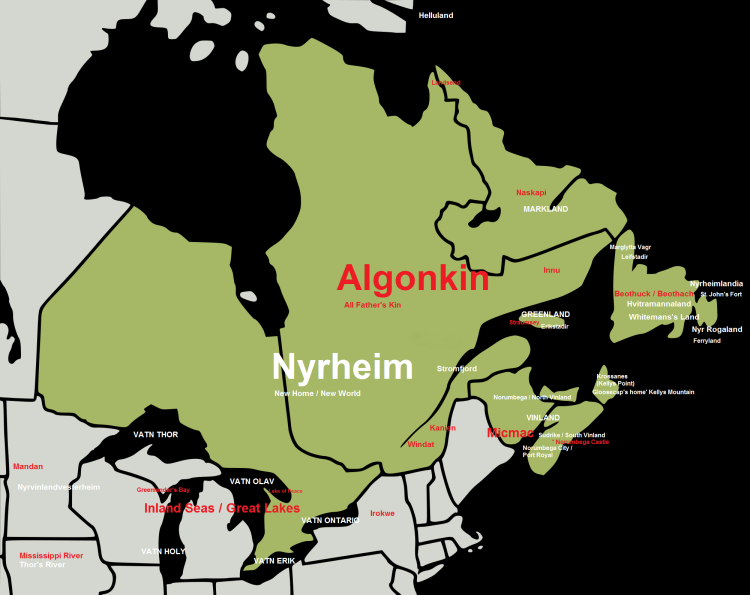Category Archives: Uncategorized
This story will go from around 700 AD to as close to the present as I can trace I will just keep adding to the bottom of the page to keep everything together. Evidence is here http://norumbegavinland.wordpress.com
Aniurunna´s tale
1.
Aniurunna had no idea where he was but he knew that he was lucky to have survived. His anorak had protected him well and his kayak was solid as ever, but this had been quite a storm.
He had gone out on to the sea in order to fish from his home on the Island of Sanikiluaq. It had been a clear, bright autumn day. He had of course noticed some clouds in the distance but he had always been near the coast, and the wind hadn´t felt particularly strong.
Aniurunna was first amazed and then frightened as he paddled up the fjord. On the both sides there were high mountains with green grasses and various plants. It was still day but the mountaintops easily covered the sun so Aniurunna was in a constant shadow. He could see neither humans, nor any animals apart from two ravens hovering in the hills.
When he was too exhausted to continue any further he made a stop in a rocky cove, dragged his kayak on shore and fell asleep in the deep grass.
2.
It was a girl that woke him up. She was touching his blond hair and smiled at him. Behind her there was an older man and an older woman. They stared at him more distrusting than the young girl.
He was surprised and almost reached for his stone blade but hesitated. His father had always reminded him that when meeting strangers it was important not to make threatening moves. He looked at the family and tried to calm himself. He was a stranger in their territory, and they´d surely tell him how to get back if they could.
“You are from the other side” the man grunted.
“The other side?” Aniurunna asked. His head hurt in the bright sun and despite having slept there a whole night his muscles still ached. “Other side of what?”
The man didn´t answer but instead pointed towards the sea. Aniurunna looked. The netherworld.
He could see a small grey stripe in the distance beyond the blue waves.
And then he gasped.
Of course! Of course! Every single day when he had gone out hunting with his father and brother, every single time he had wondered how the grey stripe on the other side looked. The Netherworld.
“It is too far” his father used to say. “And who knows what is on the other side.” He said it as if it was a bad thing, but to the young Aniurunna it sounded more tantalizing than anything.
He had asked old Ana whether she knew what was on the other side. She had given her old, crooked smile he used to love so much and say:
“Dog men, the white ghosts and crazy old Tullik and his woman Shila.
Aniurunna stood up and faced the family. The man held a spear for hunting. It had a sharpened bone, sharp enough to kill a man or a seal. He and his wife wore brown and wrinkled walrus-skin jackets, but their daughter, maybe 10 or 11 winters old wore a grey sealskin anorak.
They are no dog men, and by the sound of their breathing no white ghosts. But could it be.
“Are you by any chance old Tullik and his woman Shila?” Aniurunna asked.
Their faces revealed great surprise. They seemed to be saying: “how did you know?”
When the silence had continued for quite a while Aniurunna smiled and said:
“Old Baba sends her greetings to her sister Shila and her man Tullik, I am her grandson Aniurunna.”
Our starting point, so it begins.
3.
Tullik the woman stealer started the fire and looked amused when Aniurunna stared at him. He was not used to seeing such a lively fire. Sometimes he had seen his sisters and mother burn some grass to thaw frozen meat but apart from that nothing like this. The fire was like a living creature, reaching out with his warm hands, trying to stroke you.
But despite the smile he seemed to be uneasy with Aniurunna´s presence here.
“Are there other people on this island?” Aniurunna asked.
“Not that we know off” Tullik answered.
“How long have you been”
“Longer than you have lived”
Shila handed Aniurunna some of their meat and he felt grateful for it. He had not eaten for more than a day. The bird flesh felt just right under his tongue.
“Is my sister Sitiyok well?”
“Who? … Oh, you mean old Ana” Aniurunna answered.
“She is well. But getting old”
“So are we” said Shila and looked at Tullik.
“Do you have other children?” asked Aniurunna and looked over to Miksa. She sat silently by her father´s side.
Shila shook her head. It seemed to worry her, and rightly so, there was no way a couple their age would be able to keep up hunting in five or more winters, and without a son to provide for them.
“So will you go back?” Tullik asked.
“Will I? Of course.”
Tullik nodded but Shila shook her head.
“Go back? It is too soon for that. He needs to rest more before he can brave the ocean… that is if he thinks it is worth it”
“Worth it?” Aniurunna said.
“It´s quite a trip” Tullik said. “You came here by accident, like most of the trees that wash up on these shores. The ocean currents are quite strong. But once you´re out on the great sea on a small kayak there is no telling where you will end”
“No telling” Shila repeated. “We barely made it here ourselves and we know others have perished. Just last year found a poor hunter in the same area you were, he had drowned and seagulls eaten his eyes”
“It is a strong current here” Tullik said.
And after there was silence.
4.
Aniurunna would have surely braved the waters if winter hadn´t been approaching. The next days it rained heavily and autumn winds howled through the fjords. He aided the family in all their chores and received a fair share of food.
Tullik hardly ever spoke to him and when he did it was in an unfriendly manner. But Aniurunna became slowly impressed by the old man and the way his family lived.
First of all, instead of a narrow skin hut they lived under a cave, with the entrance covered by trees that Tullik himself had chopped down. It would be strong enough to keep out a bear Aniurunna figured, and the skins that were tied to them made sure that the cave was nice and warm.
Just like an igloo, the floors in the cave were covered by skin making it very nice and warm. Aniurunna was certain he´d miss sleeping there.
In addition Tullik had a massive amount of food. Enough to feed three or four families. Most of it was fish that his wife had dried, meat wouldn´t last as long unfrozen but Shila told him that all around they had buried seals and even some whale meat. (Of course Tullik on his own would never be able to catch any of the whales that swam along the coast, but a few months ago one had stranded on his own).{1}
Winter came without Aniurunna ever getting decent enough weather to return. He´d do it in spring he told himself, and in the meantime enjoyed the hospitality of Shila and Miksa.
{1}Two notes: Icelanders and Greenlanders didn´t have a lot of salt, but they did preserve food by burying it in the ground. Also, west fjords used to be a whale hunter’s paradise, in the 19th century French, Dutch, and British sailors often hunted there as well as Icelanders.
A concise history of Thule:
Thule is the first part of the new world discovered by Europeans. {1} But it was the last part of it that was settled by natives. In the early fifth century small bands of the Sadlermiut culture were making their way across the western fjords of north Thule. These fjords were at the time abundant with whales, fish and also various birdlife that provided eggs. (The Sadlermiut soon learnt how to harvest the eggs by tying a rope around the middle of the hunter and lower him slowly down the high cliffs).
The Sadlermiut had been crossing boundless arctic wastes at an incredible speed. A technological revolution in the form of bow, arrows and better kayak building methods attributed to their interaction with the Inuit culture caused a population boom and a fast expansion. By the third century they had reached New Norway{2} and settled it at an incredible speed.
The second population boom came when they reached Thule. According to legend five families crossed the sea under the leadership of Aniurunna. It is probably a legend since the name Aniurunna literally means a leader but recent genetic research has shown that the natives of Thule may in fact all be descendants from the same five families in the fifth century. Of course genetic research in Thule is a mess. The 7th century saw the arrival of Irish missionaries and their families settling the southern part of the island. The 9th century brought the Vikings and in the 10th and 11th century a second immigration wave from the new world brought more Sadlermiut and Innu as well. Throw into the mix 14th century German and English sailors as well as 18th century Frenchmen and the reader should be able to understand the problems facing genetic researches trying to make the genetic map of your average Thulite.
{1}Iceland in TTL known as Thule will be counted as part of America because of the native tribes already living there. In geological terms of course it belongs to both the North American plate and the Eurasian one.
{2}Greenland.
Dorset people didn´t have the bow and arrow technology and so mainly hunted seals through holes in ice. There is not much known about them. I will use standard Innu names for people and places therefore, the Dorset culture adapts bow and arrow, and other Stone Age technologies earlier and therefore manages to spread faster. A small population boom so to speak.
5.
It was on the third true spring day that Adlartok saw a mysterious boat approach from the other side of the ocean. He at first imagined it was a whale and since he was alone on his kayak he decided to keep a respectful distance.
But as it drew closer he realized it was another hunter paddling across the sea.
“Is he mad?” Adlartok wondered. “To go out onto mid-sea like that? What for?” Losing sight of the coast didn´t seem a risk worth taking to Adlartok.
He tried to keep his position and focused on the man as he approached. Then the man started waving. Hesitatingly Adlartok waved back.
“Let´s see what he wants” he thought to himself. It was not odd for travelling tribes to pass through his territory. In fact he very often traded with travelers, exchanging things both sides needed.
The man approached, sliding above the waves. It was a strong and cunning paddler Adlartok had to admit.
“Adlartok is that you?” the man shouted.
Now he really got worried. Who was that man?
“Is it a white ghost that knows my name?”
“It is neither a ghost nor a dog man. I am your brother Aniurunna!”
Adlartok could barely believe but then he recognized the grey patterns on the white anorak. His brother´s anorak.
“Is this a cruel joke? My brother has not returned whole winter. How could he still be alive”
Aniurunna smiled his brave smile.
“I´ve been in lands green, so rich with birds and fish that the foxes grow too fat to crawl into their holes”
“I can see it is you, but I cannot believe”
“It is me brother. Now, take me home, I have a story that will keep you awake for days.”
6.
Aniurunna was well received by his family but of course saddened to hear that his dear Ana had died in the winter.
“She kept talking of you” his mother assured him but that left him feeling no better.
The story he told them made their jaws drop. That the woman stealer lived on the other side of the ocean, all alone in a land of boundless wealth.
“It would be rightly named Tullik (Thule) the Greenland” Aniurunna assured them. “If we were to go we would not be in need of anything”
His mother, always a careful woman was unsure.
“What of women my son. You need a bride. We cannot go there just me, you, your brother with his wife and children”
Aniurunna agreed.
“We need more people, and I´m going to convince more to come along”
He didn´t speak more of brides with his mother. In fact he had not yet told them that he had already promised Shila he´d take her daughter for his wife when she first bleeds. He had not returned to find a woman for himself. He had come to find wife’s and husbands for his sons and daughters in the new land.
Thulean wild dogs
Descended from dogs brought by the original settlers on Thule they are formerly domesticated dogs that have become wild again. Over the years they changed quite a bit from the original sleighing dogs that the 5th century settlers brought.
Before sheep and reindeer were brought to Thule no large mammals existed for wolf like predators to hunt, and in order to adapt the dogs had to settle for less. They are in many ways not dissimilar to foxes although they are occasionally seen together in packs. That is a more recent trend after reindeers and wild sheep managed to gain foothold in Thule. Like foxes the Thulean dogs are small, nimble, hide easily and hunt smaller birds. (Though not fish like foxes are able to).
The golden age of these dogs was probably in the 9th century when their stock peaked, but settlers from Norway who brought domesticated animals saw them as threats to their livestock and started hunting them. Even though the stock has recovered since 1979 when it was believed there only were 300 left on the whole island it remains a species on the brink of extinction.
Trivia: In 2005 the Thulean parliament voted on whether the Thule dog should become a national symbol or not. They voted instead to stick with the Auk.
A Thule dog
The tall cliffs of western Thule provided the early settlers with precious proteins in the form of eggs.
7.
Aniurunna came in the fall as he had promised Shila. This time not only she and Miksa greeted him warmly but even Tullik seemed relieved that he had made it back. Neither one of them could believe that Aniurunna had convince four families to follow him.
With Aniurunna came not only his brother and his wife, but also his older sister and her husband. When Aniurunna had gone to find his sister he had managed to convince two other families that were newcomers to follow him as well. Last year’s hunting had not been too good and most people seemed to think that these days there were more people than needed in these parts.
The fjord was long enough for all of these families and even more.[1] But Tullik seemed to worry. He had originally fled after stealing his woman from a competitor and had not interacted with other hunters for more than 15 winters. His woman on the other hand had never been as happy. She volunteered to show the newcomers around, tell them what corners gave most shelter, where it was good to gather eggs or hunt for seals. In the evenings she even told stories. Stories she had maybe told her daughter countless times over the years came to life for new ears.
“She`s a lot like old Ana” Adlartok whispered to his brother.
“Yes she is… 10 winters younger but you can tell they are sisters” Aniurunna answered.
Just like he had been, the others were also impressed by all the fire they could light. Never before had an autumn night been as bright and warm.
This is of course not the end of Aniurunna`s tale. He lived to become old, raised many sons and daughters, hunted bears and whales with the other hunters living in the fjord and inspired those who were around him.
But this is not only Aniurunna`s story and we must now skip ahead and hear the tale of his descendants.
[1] According to one book I read one fjord sustained up to 300 people whose diet was based mostly on fishing. (Of course the Icelanders had milk and lambmeat as well, but in the particular case cited here the people were didn`t own animals but possibly grew potatoes in addition to fishing).
Concise history of Thule
50 years later in the Bay of Inuvik (Breidafjordur)
8.
Mauja smiled when they reached the peak of the mountain. Finally!
The baby had been sleeping on her back the whole time but it had still been quite a trial to cross the mountains. She didn`t complain, she was after all the grand-daughter of Aniurunna who had first climbed these mountains.
“It is going to be easier from now on” her husband Iluq promised her.
Obviously going down would be a lot easier. But first she wanted to stop here and take a look at the land. She`d probably never climb as high again.
“Wait for a moment, I want to see where we are going to live”
“Down there” Iluq said smiling and pointed towards a grove.
One winter ago Iluq had courted her. Their parents had already approved of the match and she knew that there was no way for her to refuse. Iluq was neither the most handsome nor the best hunter in the fjord. But they were the least related couple and that counted for a lot. [1] It had been more or less decided on the day she had been born, but anyway she let Iluq spend time trying to convince her.
He had told her about the lands beyond the mountains. Just like her grandfather had found this land they too should find their own land. And he had seen it on a whale hunt one year ago. A great cave, ideal home and shelter.
Anyone who had a good cave was lucky. There were those who still built igloos in the winter but most had either started making permanent huts out of trees or bolstered up small caverns using wood and skin. She had been raised in one of the richest caves in the fjord and would never accept living in a crumbling hut or a snow house.
“There, in that small forest is cave big enough for two families. Later on we might invite your sister and her husband to live together with us. But first we have to settle here for one winter.”
Mauja sighed and wondered how he had managed to convince her of moving. He didn`t even own his own Kayak so they had to cross the mountains on foot. He had dogs, but that would only increase the amount of meat they`d need. She wondered whether this would ever work out.
[1] Innu were very careful of inbreeding.
From A concise history of Thule:
Archeologists have uncovered many tools and bone heaps from the western fjords of Thule. Those reveal to us that the Sadlermiut culture sustained itself mostly on fish and as time passed occasionally on bird meat. Auks became a part of their diet along with ptarmigan. By the middle of the fifth century or early 6th century drastic lifestyle changes had occurred.
Primitive houses out birch and stone started appearing with fireplaces often nearby. (In the first century of settlement fireplaces were not kept indoors, instead the walls were covered with skins to keep inhabitants warm, with oil lamps used for lighting.) The bones found near these fireplaces show us that not only the diet changed, but also methods of cooking. Bird meat and whale meat was grilled slowly over fire, fish were boiled in a mix with native plants. As time passed not only berries became part of the diet but also native mushrooms and herbs.
We have no proof that the Sadlermiut went out of the northwestern part of Thule in the 5th century. It should not be surprising, for the population was still rather low and they could easily sustain themselves in that area. First clues of settlement outside of the western fjords are found in the bay of Inuvik.
It is probable that a whale hunting kayak mission may have discovered that Inuvik was very suitable for both fishing and whale hunting. In any case the islands on the bay were very suitable for the Sadlermiut. The islands may have lacked forests so housing materials had to be brought from elsewhere, but the bay was rich with life. Archeological digging show that the diet of the Inuvik settlers could add shellfish, lobsters and nutritious seaweed to its diet. Indeed, the very ingredients that make Thulean cooking famous all over the world today.
9.
Mauja sighed.
What a hopeless husband she had. For days they had been cooking seaweed and seashells, and the fish he brought were ugly and tiny.
She had to admit he had been right about the cave. After bolstering it up and constructing a passage it was ideal and would indeed be the envy of any other hunter`s wife. If there were any other people here she could boast to.
Iluq spent the evenings decorating the cave by cutting animal shapes into the sticks and bones he had found. She remembered how he had impressed her originally by giving her the animals he had carved. If he could only catch the animals he was so good at carving she thought to herself.
It will get better she tried to assure herself. But she wouldn`t have cared at all if she`d never have to eat shellfish and seaweed again.
A concise history of Thule
after successfully settling the bay of Inuvik the Sadlermiut culture spread further south and east, and eventually covered the whole island with spread settlements. All around the island there were auks, fishing, seals, walruses and similar plants.
Inuvik is also an Eskimo town in the western Arctic the Innu Viking people, Land of the Copperheads.
The Sadlermiut (also called Sagdlirmiut, or Sallirmiut in modern Inuktitut spelling, from Sadlerk now Salliq, the Inuktitut name for the settlement of Coral Harbour, Nunavut were an Eskimo group living in near isolation mainly on and around Coats Island, Walrus Island, and Southampton Island in Hudson Bay. They survived into the early twentieth century and are thought by some to have been the last remnants of the Dorset culture as they had preserved a distinct culture and dialect from the mainland Inuit. However, their culture and local traditions seem to have combined elements of both the Dorset and Thule societies, which may indicate otherwise.
It is difficult to imagine the initial reactions to volcanic eruptions. Thule is on the mid Atlantic Ocean ridge making it one of the most active volcanic hotspot in the world. While the northwestern part is relatively free from volcanoes the southern part and midnorthern parts are not. A total of 300 volcanoes are on the island with an eruption every five years on average. These eruptions have had some impact on world history even, the Eldborg eruption of 1783 caused famines as far as in Japan, and in recent memory there is the ash cloud of Qikcikkitaluuq (Kikkitalukka in Germanic Thulean) that disrupted air traffic and made life miserable for journalists concerned with spelling.
In the 6th and early 7th century there were no major eruptions but the tradition of mountain worshipping must surely have originated in that era. In the year 2010 geologists collecting samples near Qikcikkitaluuq uncovered what seemed to be offerings. The geologists had been digging to examine layers of ash when they stumbled onto early 7th century wooden bowls and Sadlermiut carvings, which had been buried with offerings of food. Such findings are very rare in the southern corner of Thule since the acidic nature of the soil is not ideal for preserving objects. Ironically the custom now is mostly preserved in the western part of Thule where natives still make offerings to sacred mountains certain times of the year. But any traces of such offerings are scarce in those areas until 12th century when Norse settlements were beginning to push the natives further and further north.
9.
“Across the bay of Inuvik there is the mountain Ulanairsigut. An impressive sight in both clear and stormy weathers. My grandmother Mauja told me many stories about it. She told me I should always respect it. The old man in the mountain hears the prayers of the people living under it and if in times of need he will come down.
You don´t believe me. The old man was here before we came here. Old Mauja was the first one to settle here. She came with her husband Iluq and their son. He died while hunting and she lived an entire winter on her own before other settlers came. It was a tough winter but Mauja was tougher. Her son didn´t live though.
People said she had become weird after living so long on her own. Maybe so, she liked talking to herself a lot. And imagining things. She told people she could talk to rocks, but she was no angakok.
She was 30 winters old and still had not remarried when my grandfather Aliq came to the settlement. He was not very liked. Rumor was that he had pushed his own brother of a cliff during a fight. I don´t know if it´s true.
He didn´t get along with others very well but he and Mauja seemed to understand each other. They were among the first to move to the islands and then they moved across the sea and settled under old man Ulanairsigut. They had seven children, three of whom lived. And then several grandchildren like me.
The further south we move, the mountains get more alive my grandmother told me. I would never have believed it until I saw the smoke rising in the distance. The old men and women of the mountains like to burn things. Their land is the inner land where there is no sea nor food to find. It is a dangerous place and dangerous.
Maybe they don´t like having us here.
But old man Ulainairsigut is peaceful. Or maybe just biding his time.
Old man Ulanairsigut or Snæfellsjökull.
Settlement of Thule at the beginning of the 700s.
Ulanairsigut is sort of similar to old man in Greenlandic Innu. I´m basing my names on that language although the Dorset culture was of course not the same. Since they are related, and it´s a long time ago, and there is a different development from I´m going to use poetic license a little bit and improvise. It will be based on something but it won´t be linguistically accurate.
The mountain mentioned is Snæfellsjökull, mostly known from journey to the center of the earth.
This is a photo from an archeological digging of what may be early 8th century Irish monks in Iceland
The coming of the Papars
First contact between Europe and the new world.
The first mention of Thule in written documents was written by an Irish geographer in the Carolingian court. Irish monks and scholars were very popular in European courts at the time due to their knowledge and skills. Liber de mensura orbis terrae by Dilcuil was written in 825 and mentions Thule or Thile briefly.
“North of Scotland on the island of Thile there is a nation whose skin is red and lives in cave. They eat only fish for earth is poisonous, Worship Mountains for they know not of our lord and make boats of skins. During summer the light is so bright all night long that one can pick lice from one´s shirt at midnight. For hundred years there have been monks living on the island who have tried to teach the people of Thule the worship of our lord but the islanders remain ignorant of the good word for the most part.”
Since the 5th century Irish missionaries had been preaching all across Europe. The conversion of England and Scotland was their work and some they had some successes in Scandinavia as well. There were “papar” as the Norse called these missionaries living in small settlement in the Orkneys and Faeroe Islands and most notably Thule. We do not know exactly when they arrived to Thule but a twelfth century manuscript written in Thule by monks in the Columba monastery claim that the monastery was founded in 712.
“The thulites approached St. Aidan´s vessel on their small boats. The other monks feared that these strange men would surely take their lives but Aidan said:
“Be calm, for these men fear us as much as we fear them. Be thankful, we came here in search of solitude but god has given us a flock to tend”
When they stopped on what the Irish monks called Brendan´s Island later St. Brendan´s Island the men wanted to touch the monks or white ghosts for they could not believe they were truly living. The strongest of them touch Aidan´s hand and then ran screaming away.
The other men followed him to their boats and sailed away. When they were gone the monks came to Aidan and asked him what they should do.
“We should go back, the men will come again and kill us in our sleep I fear” one of them said.
Then Aidan answered:
“If the Beothach come back we shall receive them with open arms for these poor men know not of Christ and the good word.” Beothach meaning “The Red Animals”
Beothuck “The Red Ochre People”
The end of Sadlermiut culture
The Sadlermiut did not disappear of course since their descendants are still living on the island. But what we call the Sadlermiut culture named after the settlement dug up in Sadlermiutfjord came to an abrupt end in the seventh century.
It is very likely that the contact with Irish missionaries brought these colossal changes in lifestyle and culture. The first major change were the plagues that killed of more than half of the population. The Columba manuscript mention that the men who helped St. Aidan to settle and found his monastery disappeared after living close to them for one year. It is possible that the white men frightened them so much that they didn´t want to live nearby. But that is unlikely since they helped these very same men survive their first winter. Aidan and his company had no plans for staying in Thule more than one summer and would have surely perished if the natives had not shared some of their food with them. When they returned from Ireland with more people, cattle and grain seeds they were surprised to find no people living there.
According to the manuscript five years passed before Aidan again encountered the “Thulites.” Why did such a long time pass?
Of course it is pure speculation that Aidan´s Company transmitted European diseases to them. But it is not unprecedented. Research has indicated that between 700-730 Sadlermiut people were dying in droves, and relatively densely settled fjords became empty. It may have been a mixed blessing. According to maritime biologists at the University of Bergen this in fact saved Thule from an environmental disaster:
“Seals, walruses and auks were all becoming scarce and in some cases people resorted to eating even dog meat. But after 730 the seals and auk population seemed to have recovered enough for them to again become a part of their diet.”
Part of the Columba monastery on St. Brendan´s Island. And of course by now you know Tullik, Thule, St. Brandan’s Isle and Iceland are all different names by different peoples, for the same Island over the centuries.
11.
My name is Sétanta.
I no longer remember my old name. Nor the names of my parents.
They lived not far from St. Brendan´s Island. On the coast.
I remember the smell of grilled Auk meat, seaweed soup and the feel of my mother´s white seal skin coat. I remember some faces, maybe I had brothers and sisters, uncles and aunts or even grandfathers and grandmothers. When I dream I dream of a whole village, but when I wake I can barely remember anything that happened. Just the faces and no names.
I can remember the day before father Aidan picked me up. Something terrible was happening in our village. My parents had boils and rashes, and there were terrible coughs. Coughs that could tear your soul apart.
I had a high fever and my mother stood crying over. Then she fell silent. And for a while there was just darkness.
According to father Aidan my people had all died and I was out in cold. Stumbling feverishly by the seaside when they saw me.
They brought me on board the boat and wrapped me in warm blankets.
I do not remember the first days at all. But once my fever subsided I could explore the island as I liked. They could not speak to me so they did not try to teach me much at first. I could wander freely although they forbade me to climb the rocks. The valley was amazing to behold, full of sheep and in the mountains puffins soaring.
Did I miss my parents? I was six or seven winters old which is probably enough to feel sorrow. But to tell the truth I don´t know. Maybe the fever made my feelings go numb, maybe I decided to forget everything on my own, and maybe the sorrow was too big for me to remember it clearly.
A year passed on the island and I soon started to learn how to speak. The first words I was taught were: Spoon, bowl, see, sit…
Soon other followed: Sheep, bird, sky, Jesus our lord and Savior, ocean, father, and brother.
Aidan did not pay me much attention. We hardly ever spoke. But sometimes I noticed him looking at me secretly. As if he had big plans for me.
12.
“Sétanta, come here” father Samuel said.
“Father”
“How old are you?” the old man asked. He sat on a rock overlooking the whole island with a loaf of cheese in his hands.
“I do not know, maybe sixteen years of age or seventeen we think”
“Grown man I see” Samuel said and handed him a huge chunk of the ewe´s cheese.
“I am the youngest one here”
“Maybe so, but no longer a child” Samuel said. He looked towards the ocean.
“How many times have you gone to the mainland?”
“Three times father” Sétanta said.
The old man nodded.
“But you know that is where you came from”
“Of course father. I´ve been brought up here but I was born in Thule”
“Do you remember anything of your time there”
“No, not much. I cannot speak the Thulite language nor know their ways”
“That is a pity”
“But father I have learned a lot here. I know how to read, and I can tend the land, the sheep…”
“That is so, but you do not know how to hunt a seal or row a kayak”
“No, I was too young to learn such things”
The old man nodded his head again and knuckled his brows.
“We, the brothers have been discussing this for a long while amongst us and we have decided that it is time for you to return”
“Return?”
“What do you think of that?”
Sétanta was absolutely dumbfounded.
“Return? To where?”
“Now you see Sétanta we´re not throwing you into the ocean. I know fully well you are a Christian and a very good one. We have been arranging things with Uyarak…”
“Uyarak, the one who brings us whale meat?”
“Yes, that Uyarak. He´s been happy to exchange with us meat in exchange for many things but the next time he comes we will do an even bigger trade.”
Sétanta had a bad feeling about this.
“You must go with him. He will teach you how to hunt and from his family you may learn to speak your parent’s language…”
“But father!” Sétanta nearly shouted. “I do not wish to leave the island. I´m happy here with the brothers”
“You know nothing of the world Sétanta. You´ve not even seen a woman in your life. But you are lucky for you have great role to play”
Sétanta shook his head.
“We the brothers are old and as much as we´ve tried we´ve never succeeded in gaining the trust of those who live on the mainland. We´ve never understood their language and never been able to teach them of our lord. But you Sétanta, you could be our bridge, you could be the savior of Thule the Beothach Papar.”
Sétanta never forgot the betrayal of the Long Shirts. Who turned him away from the only family he knew only to want him to make his own people their flock of sheep. Sétanta grew to be a man who knew both peoples and languages. As the Papar Monks predicted Sétanta lead his people but not to them as they knew he would. He took the Thule children of Tullik across the seas to the Netherworld to find the Thule Greenland’s where they could find the pasture lands the Vinland’s where the Red Animals could call home The Land of the Beothach’ s. He took on the name of the first leader of the Thule
Aniurunna, Koo Cho Lin (Wise Old Owl Man) Koo Cho – sound of the Owl and Lin or Linu meaning man. Linaki (Linape), Men Land. Lin meaning Man and Aki meaning Akr or Acre meaning land. People and the land are one being.
Aniurunna (Setanta) would return to the land of his birth and later to find his people in Ireland his Beothuck name is Koo Cho Lin (Wise Old Owl Man) in Ireland he would be remembered as Cú Chulainn. And he would return many times to the Netherworlds to his people in Greater Ireland Hvitramannaland (White Man’s Land) The New Found Land or Nyrheimland. There they settled on the south coast called Avalon in the village of FairyLand in the Netherworld. Today Called Ferryland, on the Avalon Peninsula of Newfoundland.
Anticosti Island
For thousands of years, Anticosti Island was the territory of the indigenous peoples who lived on the mainland and used it as a hunting ground. The Innu called it Notiskuan, translated as “where bears are hunted” and the Mi’kmaq called it Natigôsteg, meaning “forward land”.
Boreal forest on Anticosti Island
The Skálholtsbók, written about 1420, recounts how Thorfinn Karlsefni on his voyage to Vinland “reached a fjord with an island near its mouth, where there were strong currents, and called the island Straumsey (Stream island). There were so many birds there that they could hardly walk without stepping on eggs. They sailed up into the fjord, which they called Straumsfjord” If Straumsfjord is identical with Saint Lawrence River, Straumsey could be the first reference to Anticosti Island in history.
On and around Anticosti millions of Garnets and Puffins nest each year. It is home of the largest migratory bird park in North America
This is found on quarry Island in sight of Anticosti Island where Koo Cho Lin (Wise Old Owl Man) lived.
The Hound.
Jacques Cartier
Jacques Cartier, the explorer and adventurer, cursed Anticosti Island as the land that God gave to Cain. He often referred to the island as Jinx Island and also as the strangest island in the world, for its dangerous coast of treacherous reefs and rocks chilled by the Labrador Current.
1918 Excerpt: …they went on board and sailed in the sound that lay between the island and the nes that jutted out to the north from the land. They sailed westward past the nes. As we have shown above, they were in the Strait of Belle Isle. The Labrador shore goes southwest and the Norsemen followed the coast. About 240 miles away lies the large island of Anticosti between this coast and Gaspe. The island is about 30 miles wide and 135 miles long. The west part lies north of Gaspe. Heavy fogs in the summer often cover the Gulf and obscure the vision. But in clear weather one can easily see from Anticosti to Gaspe. When they saw Gaspe opposite them, they went back to the ship and sailed in the strait and followed the coast of Gaspe westward. The sweet dew that the Norsemen found in the grass may have been what is known as “honey-dew;” but I have not been able to ascertain whether it exists on the island of Anticosti. The saga attempts to give sailing directions to Vinland.’ From the strait one is to follow the coast of Labrador, or Markland, to the large island of Anticosti. There are many small islands along this coast, but only one of large size and only one lying north of the land of Gaspe. On reaching this island, they are to take the south channel and follow the Gaspe shore westward. As the island has a slanting position, they may have thought it nearer to Gaspe than it really is. On our earliest maps we find it drawn too near Gaspe. The enumeration of doegr, or distances, in this saga ceases at Anticosti. In the following explorations we find only directions, no doegr. The distance from Greenland to Anticosti is nine doegr or about 1180 miles, if according to Rymbegla we assume that one doegr corresponds to two degrees of latitude, or 120 geographical miles….
Preface
It may seem implausible that Vikings would discover the mainland of America before actually discovering Greenland.
However one should not underestimate the power of chance. The discovery of Iceland and Greenland were by chance. The one that told Erik the red about Greenland was a settler named Snæbjörn (incidentally my name as well), and he had stumbled on it because his ship had been blown of course on his way to Iceland and Thullik who discovered Thule and Aniurnna who followed in his footsteps.
Now, it is easy to see looking from a map how you automatically hit Greenland if you miss Iceland.
I have in my hands from a journey to another timeline a manuscript of a different Erik´s saga the red in which he also by chance ends up even further than Greenland and ends up settling there.
It might not seem likely that someone could end up finding the continent of North America by getting lost at sea, but that is exactly what happened.
Leif the lucky, son of Erik head of the new world from a friend that had been caught by a storm on his way to Greenland and seen another land. Bjarni Herjólfsson is now a mere footnote in the history of explorations, Leif who decided to explore the land Bjarni had seen and Leif was the one that got the statue in centre Reykjavík and Minnesota.
But what if this had happened sooner? In the year 960 Erik was an outlaw from Norway and from Iceland who explored Greenland for three years before he convinced enough people to fill 25 ships to follow him to Greenland. He lied to them that the grass was greener and better on the other side.
But what if he didn´t have to lie? What if he, like Bjarni Herjólfsson had been caught by the flapping wings of Pegasus a kenning for sea horse or Ship with horses head in the prow the sails being the wings? As it flies over the water (Goes very fast) Or on land flies through the ice fog (snow) from realm to realm (place to place) on an eight legger or sleipnir – Sleip meaning slippery or slipper in Old Norse and Nir meaning to plow. Sleipnir or eight legger Slippery Plow or two horse Sleigh – Sleipnir
Now Come the Viking Men of the Norse
The names of Iceland
In Icelandic
Many names have been used to refer to Iceland in the Icelandic language. These names include colloquial, formal, and poetic forms:
- Eylenda, fem.—island, that is to say Iceland
Stephan G. Stephansson
Fjarst í eilífðar útsæ
vakir eylendan þín.
Far in the eternal yonder sea
your island wakes.
- Fjalladrottning, fem.—queen of the mountain or Iceland
- Fjallkonan, fem. with definite article—lady of the mountain, a figure representing Iceland
- Frón, neu.— old Norse word for land, Iceland
- Heima á Fróni.
- Garðarshólmi, masc.—Iceland, named after Gardar Svavarsson
- Hrímey, fem.
- Hrímgrund, fem.
- Hrímland, neu.—(the book Crymogaea occasionally uses “Hrímland”)[1]
- Ísafold, neu.
- Ísaland, neu…og flykkjast heim að fögru landi ísa.
- Ísland – Iceland’s official and most common name
- Jökulmær, fem.—Young woman of the glacier, Iceland
- Klakinn, masc—literally the iceberg
- Norðurey, fem.— literally meaning “northern island”, used in jest in the Westman Islands since Iceland is north of them
- Skerið, neu-literally the skerry
- Snjóland, neu.—Snowland
- Snæland, neu.—the name that the Viking Naddoddr reputedly gave to Iceland in the 9th century meaning “snow land”
- Thule, neu.—some scholars claim Iceland was the land of Thule.[2]
- Týli, neu.—Thule
- Þyli, neu.—Thule
Icelanders also have their own nickname for themselves, Frónbúi (literally meaning “an inhabitant of Frón”).
In Latin
Iceland has prominently been called by three names in Latin:
- Islandia – directly from Icelandic language “Ísland”
- Snelandia – a Latinization of the more poetic name Snæland
- Insula Gardari – literally meaning “Island of Garðar”, compare Garðarshólmi
An unlikely leader
Grímur Kamban was, according to the Færeyinga saga, the first man to set foot in the Faroe Islands. The name was written Grímr in Old Norse and is often referred to as Grim in the English literature.
The saga says, he was a Norwegian Viking escaping the tyranny of the Norse king Haraldur Hárfagri. However, this is an error in this saga, because Harald’s age was in the late 9th century, while the first Norse settlers reached the Faroes after 825.
Furthermore, the name Kamban indicates a Celtic origin. Thus he could have been a man from Ireland, Western Isles or Isle of Man, where the Vikings had already settlements. Another theory says, he could have been an early Christianized Norwegian under the influence of Irish monks there.
“According to the Faereyinga Saga… the first settler in the Faroe Islands was a man named Grímur Kamban – Hann bygdi fyrstr Færeyar, it may have been the land taking of Grímur and his followers that cauysed the anchorites to leave… the nickname Kamban is probably Gaelic and one interpretation is that the word refers to some physical handicap, another that it may point to his prowess as a sportsman. Probably he came as a young man to the Faroe Islands by way of Viking Ireland, and local tradition has it that he settled at Funningur in Eysturoy.”[1]
If Gaelic, the first part of Kamban would originate in the Old Gaelic camb crooked (found in the Scots names Campbell Caimbeul Crooked-Mouth and Cameron Camshròn Crooked Nose). The word Kamban itself would there most likely be from cambán (Modern Irish camán, Scots Gaelic caman, Manx camane), roughly translatable as crooked one. The sports reference refers to the use of camb also in the term cambóg, which refers in origin to the type of stick used in games like hurling, hockey and golf.
It was also Irish monks, who settled in the Faroes from about 625, which is today proved by botanical researches. According to Dicuil, those monks left the islands before 825 after Viking raids. Thus Grímur Kamban is supposed to be the first man, who re-settled the Faroes.
It is said that he settled down in Funningur on Eysturoy. The name funningur means finding. Excavations have shown Viking houses in this area, as well as all over the Faroes.
Ingólfur Arnarson (Another Arnold) (Icelandic pronunciation: [ˈiŋkoulvʏr̥ ˈartnar̥sɔn]) is recognized as the first permanent Nordic settler of Iceland. According to Landnáma he built his homestead in (and gave name to) Reykjavík in 874. Although recent archaeological finds in Iceland suggest settlement may have started a little earlier, the date is probably not too far off.
The medieval chronicler Ari Thorgilsson said Ingólfr was the first Nordic settler in Iceland, but mentioned that “Papar” – i.e. Irish monks and hermits – had been in the country before the Norsemen. He wrote that they left because they did not want to live amongst the newly arrived pagans. The Beothach had left for Greener lands to the west Anticosti Island some centuries before.
Landnáma (written two to three centuries after the settlement) contains a long story about Ingólf’s settlement. The book claims he left Norway after becoming involved in a blood feud. He had heard about a new island which Garðarr Svavarsson, Flóki Vilgerðarson and others had found in the Atlantic Ocean. With his step brother Hjörleifr Hróðmarsson, he sailed for Iceland. When land was in sight, he threw his high seat pillars (a sign of his being a chieftain) overboard and promised to settle where the gods decided to bring them ashore. Two of his slaves then searched the coasts for three years before finding the pillars in the small bay which eventually became Reykjavík.
In the meantime, Hjörleifr had been murdered by his Irish slaves because of his ill-treatment. Ingólfr hunted them down and killed them in the Westman Islands (Vestmannaeyjar, named after the slaves).
Ingólfr was said to settle a large part of the south-western part of Iceland, but after his settlement nothing more was known. His son, Þorsteinn Ingólfsson, was a major chieftain and was said to have founded the first thing, or parliament, in Iceland. It was a forerunner of the Althingi.
The name Ingolf, similar to the name Adolf that means “aristocratic wolf”, would be translated as “royal or kingly wolf.”
Naddod (Old Norse: Naddoðr or Naddaðr, literally “studded”) was a Faroese Viking who took the credit for the discovery of Iceland from Ingólfur Arnarson. Naddod was also one of the first settlers on the Faroe Islands after Grímur Kamban became the first to settle there around 825. Naddod was born in Agder, which comprises the two Norwegian counties of Aust-Agder and Vest-Agder.
Landnámabók, a medieval Icelandic manuscript, describes in considerable detail the settlement (Icelandic: landnám) of Iceland by the Norse in the 9th and 10th century. According to Landnámabók, Iceland was discovered by Naddod, who was sailing from Norway to the Faroe Islands, but got lost and drifted to the east coast of Iceland. Naddod came upon the shore of a land with a bay and mountains near what is today the Icelandic town of Reyðarfjörður. Although he climbed a mountain to look for smoke rising from fireplaces he saw no sign of humans. Naddod decided to continue his journey to the Faroe Islands, but as he returned to his boat it started to snow and so he named the land Snæland (Snowland). The island later became known as Ísland (Iceland). (See names of Iceland).
Naddod is probably the father of Ann Naddodsdóttir from Shetland. And Naddod also had a brother named Oxen-Thorir who had a son named Ulf Oxen-Thorisson. Who had a son named Asvald Ulfsson who had a son named Thorvald Asvaldsson
Erik Saga Chapter 2:
There was a man named Thorvald, the son of Asvald, the son of Ulf, the son of Yxna-Thoris. His son was named Eirik. Father and son removed from Jadar (in Norway) to Iceland, because of manslaughters, and occupied land in Hornstrandir, and dwelt at Drangar. There Thorvald died.
The Thrall owner (White Slaver) and convicted murder has a son who had a son named Erik who followed in his fathers footsteps buy becoming a White Slaver and Murderer.
Erik was born in Norway, Rogaland. He was red haired, red skinned and strong, like a Boethach a Red Animal, and had a foul temper and was convicted by the Þing of Rogaland for murder. In what is probably somewhere around the year 960 he settles in Iceland. There he kills another farmer over an argument about a borrowed shovel. And another one over an argument about slaves. It is decided on the Althingi that he is no longer wanted on Iceland and the young chieftain is forced to go looking for another place to live. After one winter on a small island named Bearisland he takes the advice of a friend Gunnbjörn Úlfsson son of Ulf the Crow and goes into the west in search of Gunnbjarnarsker a supposedly a Greenland with many trees and much food.
Eriks saga chapter 5:
“Three winters passed and no news were heard of Erik. His former neighbours did not grieve this and some even said that Gunnthor son of Valthjof had paid a volva to conjure a storm against him.
But in the fourth summer since his departure Erik returned. He landed in Isafjordur with expensive and strange looking skins. He sold the farmers there timber which was greatly needed and instead he wanted all iron he could get.
He rode with his friend Snæbjörn Galti to Althingi to speak in front of the assembly. This was allowed for there was a great interest in where he had been.”
Erik must have been a very charming man for he managed to get 25 ships with him to make the journey. Only 14 made it, but once they were there the rewards were rich.
“I have found a land and I have named Greenland for it is big and green. But I need strong men with me to settle it for it is empty”
Ivar Bardson wrote that “On the mountains and lower down grow the best of fruits, as big as apples and good to eat. There also grows the best wheat that exists.”
The land was indeed green but empty no. Erik lied in order to get as many settlers as he could and didn´t tell anyone that he had encountered and fought many so called Skraelings.
In fact he had ended up settling on an island far from where he originally wanted where the Skraelings were few and friendly.
The plague
Upon reaching where Erik wanted to settle he raised a nidstong, that is a pike with a horse or a dragon´s head, to drive all the spirits of the country wild so that the Skraelings would disappear.
(This is something vikings actually did towards enemies and thought had some magical effect).
Erik traded with the Skraelings where he lived and was very friendly. When the Skraelings started mysteriously dying Erik was credited by his followers to be a powerful magicians, a Seiðskratti. The first settlements were not big and there was no althing. In fact Erik became an absolute ruler deciding nearly everything, just the way he had always dreamed of.
The heir
Erik had two sons, Thorvald and Leif. According to Eriks saga Thorvald was close to his father but Leif closer to his mother. In fact Leif and Erik often got into arguments and this frustrated Leif.
In the end his mother convinced his father that Leif should get a boat and go back to Iceland or Norway to get some experience or at least a wife. Erik grudgingly accepted since he realized that it would be better for the colony if Leif could come back with a few more settlers, preferably women which were way to scarce.
Leif travelled for a few years. According to the saga he hunted down a bear and offered the skin to Olaf Tryggvasson the king of Norway. It´s through him that news of Greenland came to Norway but at this point the king was more interested in christianizing Norway than anything else.
At the court Leif baptized then he went on “viking” in England and came by in Iceland on the way home.
That was to be the defining moment in his life and perhaps a defining moment in the history of the new world.
The christianization of Iceland the lucky chance of Leif
Leif came to Iceland a baptized and christian man, but he left as pagan and heathen as ever.
This is the year 1000 and the Icelandic commonwealth is undergoing something that one might call a constitutional crisis. It´s on the verge of a civil war.
Althingi is discussing the crisis. First of all, Olafur Tryggvason the king of Norway has many icelandic young men taken as hostage and he threatens to kill them if the Icelanders don´t convert. Some Icelanders have already converted and want to force everyone else to convert. The year before there were some killings because of this. An Irish rouge priest by the name of Brandur Later St. Brandon roams the country threatening to burn down houses if people don´t convert, but at the same times pagans prepare for a showdown at Althingi.
All sides are heavily armed.
Þorgeir the Godi of Ljosavatn leads the pagan faction. He is considered by both sides to be the most wise icelander alive.
He is willing to negotiate.
People express doubts though. And young charismatic viking newly arrived from England walks by the pagan camp and holds a speech:
“These feuds are folly. There is plenty of land where I have been. In the west a much bigger and much richer land can be found. Follow me and you may worship whoever you please as long as you are willing to work hard and reap your rewards with me” Leif spoke.
Then Gunnthor the old spoke:
“In the west there is nothing but ice, I´ve seen it myself and so have all others.”
“No, the lands in the west are more vaste and more rich than you can imagine. Why fight over a land so small and so difficult when a much easier one can be taken for free?” Asked Leif.
And many men, young and old decided to follow Leif to the west for he had well spoken and promised many beautiful things.” (Erik´s saga chapter 45).
The foundation of Vinland´s thing
Leif married Þorgerði Gunnthor´s daughter and with him came 50 ships, twice as many as had followed his father.
When he came back is father was amazed and welcomed him heartily. But his joy turned to anger when Leif explained he intended to settle further south and build his own town.
This lead to the first norse split in the new world. Leif and his followers sailed south to a land which they named Vinland. This was because a slave that Leif had bought in England claimed to have found grapes in the forest.
Two winters later the Vinlanders founded a thing. This clearly shows the difference between Leif and his father, one considering himself a supreme chief a pseudo king and the other one more liberal. As time passed more settlers started arriving from Iceland hearing of this colony and soon Vinland had become a lot bigger than Greenland (Anticosti Island).
Erik died shortly after and Thorvaldur, Leif´s brother became the chief of Greenland.
According to Vinlander´s saga written in the 13th century by Snorri Sturlusson, (An icelandic chieftain and poet), the migration really started when St. Olaf became king of Norway. This fanatic Christian burnt down most temples in his kingdom, blinded people, ripped out their tongues and took of their legs in order to force them to become Christians.
Many norwegians fled to Iceland which suddenly had vacant space, but some found the athmosphere there to christian and moved to Vinland.
In either the year 1020 or 1021 the Vinland´s Thing bannes christianity in Vinland. Leif opposed this fiercely and defended his friend and former slave Tyrkir, (who incidentally had named Vinland), and Erik took credit for it, who had constructed a church.
It was in vain, for the church was burnt down and Tyrkir was killed. After that Erik returned to Eriksstad and lived with his brother for a while. When he came back he avenged Tyrkir by killing Aslak the man who had killed him. It didn´t go very well, some wanted to outlaw Leif but his popularity saved him.
Skraelinga wars and the first church
The vinlanders learnt a lot from the natives. They started to grow their crops and hunt in the way they hunted. The micmac natives in the South of Vinland called Sudrike with their capitol in Norumbega City were wiped out by a plague but others came from Norumbega and were less friendly. This is a bit confusing Vinland was divided into North and South. North was called Norumbega the South was called Sudrike and the Capitol was in Sudrike and called Norumbega City (Annapolis Royal).
It is certain that the Vinlanders were arrogant towards them, as the vikings were towards most other ethnicities as like the sami. The sagas of Iceland claim that the Vinlanders had three great wars against the Skraelings, two which were started by Skraelings and one started by the Vinlanders which stole women and children to use for slaves.
Eriksstad did not enjoy the good land Vinland had, but essentially became a trading port. Gunnar Thorvaldsson became the first Jarl of Greenland (Anticosti Island) and started employing soldiers who claimed toll from traders.
His ships bought goods from vinlanders and sailed with them usually to Iceland but sometimes Norway as well.
Haraldur Hardradi offered Gunnar to become a jarl in his service to which Gunnar said no. However, the emissary of Harald managed to christianize him.
Gunnar built the first permanent church in the new world but left it up to his men whether they wanted to convert or not.
Landnámabók
According to the Landnámabók, Ari Marsson discovered the land six days’ sailing west of Ireland. This journey is thought to have occurred around the year 983.
Their son was Ari, who drifted to White Men’s Land, which some people call Greater Ireland. It lies in the ocean to westward, near Vineland the Good, said to be a six day sail west from Ireland. Ari couldn’t get away, and was baptized there. This story was first told by Hrafn Limerick-Farer who spent a long time at Limerick in Ireland. Thorkel Gellisson quoted some Icelanders who had heard Earl Thorfinn of Orkney say that Ari had been recognized in White Man’s Land, and couldn’t get away from there, but was thought very highly of.
Saga of Eric the Red
White Men’s Land is also mentioned in the Saga of Eric the Red, where it is related that the inhabitants of Hvitramannaland (Greater Ireland) speak of it to Thorfinn Karlsefni;
Now, when they sailed from Vinland, they had a southern wind, and reached Hvitramannaland (Greater Ireland), and found five Skrælingar; one was a bearded man, two were women, two children. Karlsefni’s people caught the children, but the others escaped and sunk down into the earth. And they took the children with them, and taught them their speech, and they were baptized. The children called their mother Vætilldi, and their father Uvægi. They said that kings ruled over the land of the Skrælingar, one of whom was called Avalldamon, and the other Valldidida. They said also that there were no houses, and the people lived in caves or holes. They said, moreover, that there was a land on the other side over against their land, and the people there were dressed in white garments, uttered loud cries, bare long poles, and wore fringes. This was supposed to be Hvitramannaland (Greater Ireland) (White Man’s Land). Then came they to Greenland, and remained with Eirik the Red during the winter.
Eyrbyggja saga
In the Eyrbyggja saga, Gudleif Gudlaugson and his crew had attempted to sail from Dublin to Iceland, but was instead driven out to sea, “first west and then south-west, well out of sight of land.” They finally arrived in a land they did not know where was, but that seemed great. Later, the inhabitants of the land came to meet them, and the Norse thought they seemed to speak Irish. Soon, hundreds of these people came to attack and capture the Norsemen, and marched them inland to a court to be tried and sentenced. The Norse then understood that these people wanted to either kill or enslave them, but were soon saved by the intervention of an Icelandic-speaking leader-figure who lived among the people. He started asking detailed questions about people in Borgarfjord and Breidafjord in Iceland, and gave the Norse some items to give on to specific people there. He also claimed that Gudleif had been lucky to arrive at the place, because “this is a big country and the harbours are few and far between.” Although the man did not want to reveal who he was (reportedly to keep his “kinsmen and blood-brothers” from getting in trouble by trying to visit him), the Norse later took him to have been Bjorn the Breidavik-Champion, who had been exiled from Iceland some thirty years earlier.
The described circumstances in this report, has led some to connect it with Great Ireland, although this is not explicitly stated in the Eyrbyggja saga. The voyage is thought to have been undertaken in 1029.
12th century Norman Sicily
In the 12th century, in Norman Sicily (where the Normans probably brought the belief with them from Scandinavia), the Arab geographer al-Idrisi in his famous Tabula Rogeriana mentioned Irlandah-al-Kabirah (Great Ireland). According to him, “from the extremity of Iceland to that of Great Ireland,” the sailing time was “one day.” Although historians note that both al-Idrisi and the Norse tend to understate distances, the only location this reference is thought to have possibly pointed to, must likely have been in Greenland.
Hauksbók
The Hauksbók states that the inhabitants of Hvítramannaland were albani, meaning people with white hair and skin.
16th century Iceland
In a 16th century Icelandic text, a chart had apparently been made of the land;
Sir Erlend Thordson had obtained from abroad the geographical chart of that Albania, or land of the White men, which is situated opposite Vinland the good, of which mention has been before made in this little book, and which the merchants formerly called Hibernia Major or Great Ireland, and lies, as has been said, to the west of Ireland proper. This chart had held accurately all those tracts of land, and the boundaries of Hvitramannaland (Greater Ireland), Einfœtingjaland, and little Helluland, together with Greenland (Anticosti Island), to the west of it, where apparently begins the good Terra Florida.
The first century
By the end of the 11th century a new commonwealth had been established, and one small jarldom had been built. The jarldom of Erikstadir, based on the small island of Greenland (Anticosti Island) was similar to Jarldoms such as Orkney. Basicly a small trading town with a chieftain.
The commonwealth on the other hand was no equal in size to it´s Icelandic predecessor and identical in almost every way except non-christian. In fact so fiercely antichristian that they pursued and killed three Irish monks that came to Vinland.
The Jarls of Erikstadir were christian and as time went on, the population which was more in touch with Norway and Europe christianized as well. This caused some mistrust between the two new factions.
In 1109 a battle came up between the soldiers of the Jarl and a few vinlanders that refused to pay toll. In 1110 the Jarl demanded of the Vinland´s althingi that it would allowed priests from the jarldom to convert those willing to convert.
Many people at the althingi spoke up for the Jarl´s side and claimed that the Irish “Long Shirts” Papar killing one generation back had been dishonorable.
This spelled doom for the Jarl, Leif Gunnarsson. In 1113 ships from vinland attacked Erikstadir, burnt down the church, killed the Jarl, his sons and robbed his treasury.
This marks the end of the first jarldom but also the beginning of the vinlandic isolation. Hearing of this, settlers coming from Norway and Iceland decided to settle far from Vinland, deciding to sail even further south, leading to the establishment of the second Jarldom.
Sturlungaöld- The age of the Sturlungs
Icelandic society underwent a great social change in the 12th century. The local Godis who used to be nothing more than lawspeakers only slightly more important than other farmers became chiefs.
This happened because of the church, or rather the way christianity was implemented in Iceland. The local Godi´s became responsible for the local churches and as such he could gather tithes to keep them running. Soon all farmers were paying them tithes or one tenth of their food production, which they used not always in the interest of the community.
At the end of the 12th century some had become more equal than others and not every free man was as important in Althingi. Those unhappy with the evolution often moved to Greenland or Vinland, where the grass was literally greener. They were quickly replaced by farmers that fled Norway and the wars of the kings there. In the past farmers coming from Norway could easily get land for free or buy cheaply, but now since Iceland was more or less owned by the Godis they had to settle down and rent land.
Those who didn´t want to accept the terms and were brave enough went further and moved all the way to the new world.
Since it was a risky voyage and the Vinlanders were known to be unchristian and even antichristians, most stayed in Iceland.
The age of Sturlungs starts in the 13th century when local warlords start fighting over the power of Iceland. Some Godi´s had the idea that they should become kings over Iceland, others wanted Iceland to join Norway so that they themselves could become jarls, (earls), serving as second in command under their Norwegian overlords.
Despite these violent times many literary achievements were made in the monasteries of Iceland. Snorri Sturlusson, the chieftain of the most powerful family, the Sturlungs, wrote himself Heimskringla (the story of the Norwegian kings from the 8th century), the Edda (collection of ancient poems with explanations for christians) and The Vinlandian saga: several small episodes about the lives and adventures of vinlandic settlers.
The age of Sturlungs ended in 1289 when Iceland was united under Kolbeinn Húnvetningagodi, who became Jarl in the name of Sverrir king of Norway.
TIMELINE
940-birth of Erik the red
970-the foundation of the Greenland colony on Anticosti Island
1000-the foundation of the Vinland commonwealth-christianity accepted in Iceland.
1000-1100 peace in general, the Vinlanders fight skraelings occasionally.
1100-1200 Vinlanders discover and explore the great lakes (Inland Seas) without settling though. They learn more about their neighbours and discover Tobacco.
1300- with Iceland becoming part of Norway and the king of Norway growing more powerful the first royally backed colony comes to live in Newfoundland. However the bubonic plague puts a hold on expansion for the Norwegians, and nearly wipes out the Vinlanders and the Jarldom.
-Horses are captured and tamed by indian tribes on the plain. The indians have no idea were those mysterious creatures came from.
-A mysterious plague coming from the north wreaks havoc in Mesoamerica,
from the ashes a new empire rises.
1400- only to be conquered at the end of the next century by a barbarian tribe that gains an advantage on the battlefield thanks to horses.
The social changes of the Vinlandic commonwealth
The law speaker and the supreme speaker
some claim that the Vinlandic commonwealth was the first democracy, others say it was the Icelandic one. A few point out that Things weren´t government and that the things were a common marketplace and place to discuss the law. Things existed with or without kings in most Germanic societies.
The Thing of Iceland undertook dramatic changes after Christianization. Things rarely changed their laws they upheld the same traditional ones and merely discussed how they should be implemented. There was no police but a system of revenge. If someone did you wrong and the thing gave you it´s blessing you could take money from that person or even kill her. Things were a place where people got married and divorced as well.
The law speaker was similar to the Dalaigh of Ireland. It was a person who knew by heart the ancient laws. The Dalaighs became outdated in Christian Ireland and so did the law speakers in Iceland. The speakers became forced to abandon the old laws and take up new laws from the Old Testament. The laws from the book of Moses were quite often more cruel, especially towards women than the old laws. Like the Muslim laws of the Middle East.
No such transition occurred in Vinland which continued the pagan tradition where all were equal. The smaller Thing of Greenland was slightly more Christian influenced but seems that by the year 1300 influences from Vinland had turned it more pagan than before.
Vinland didn´t emulate the Icelandic commonwealth. In fact the situation was different. The Vinlanders fought three wars against native tribes south of them, during which they expanded a little, and by doing so they became a different culture.
By the year 1100 the system was unchanged except for a minor detail. The supreme law speaker which formerly was only the wisest man who gave council and was not the sole decider at trials, became a war leader.
He did not become a king in the traditional sense although he sacrificed to Odin in the same manner.
The supreme law speaker had the right to call all young men capable of bearing arms to battle. And he received some sort of taxes as well, because he was to be capable of feeding those men while the war lasted.
The difference was that the supreme law speaker had no claim to a throne and was elected by other law speakers.
He had to be rich and own enough land to have a surplus of food. It was considered an honour to be the supreme law speaker but it cost probably more than one could earn.
The law speakers therefore often avoided wars because if there was no war they could keep their tax and in case of war they had spent all they had to supply the troops.
Usually the supreme law speakers only lasted a few years before a new was elected.
All this is explained by Snorri in the saga of the Vinlanders. According to him only two had served as supreme law speakers, Einar and Bjorn, indicating that this was a recent development by his time.
That may be, runic stones mention the Supreme law speakers: Olaf, Einar, Tryggvi, Helgi, Karl, Birgir but there is no way to know when they existed. We only know that Tryggvi defeated the “arrow people” (Vanir – Veneer “n woodworking, veneer refers to thin slices of wood’ Kinderling wood) and that can hardly be considered a clue in trying to find out which native tribe the Vinlanders were fighting at the time.
Further corrections-plus a small segment on foreign affairs
Attitude towards various Skraeling tribes:
The Micmac– the neighbours of the Vinlanders. They compete with them for land and get into war with them. The Vinlanders are on their worst behaviour towards them and the Micmacs aren’t fond of them at all. Eventually though the Micmacs either migrate south or get killed as the Vinlanders already gained upper hand when diseases started killing Micmacs. There isn’t much for the Micmacs to have, after all the Vinlanders hunt most animals in their nearest area to extinction, except for the fish, and clear away forest so that they can have fields. The Micmacs that accidentally kill sheep or horses get attacked constantly.
For some reason the Vinlanders refer to them as sons of the land.
Beothuk-The area of the Beothucks- or the red ones as Vinlanders call them- is Newfoundland. It is called Whiteman’s Land. The Beothucks flee into the forest rather than encountering settlers. The first settlers arrive from Norway in the year 1300 to found, what is called the second jarldom. These first royalists of the new world aren’t very lucky though. When a big part of their population dies in 1309 due to the bubonic plague a Beothuk raid finishes them off.
The Vinlanders don’t care much about the red ones, one way or the other and leave them be.
Inuit- Icelandic traders start trading with them in the beginning of 14th century for fur. Other than that not much happens. Why on earth would anyone in their right minds want to settle Gunnbjarnarsker (Greenland) when you could just as well go to Vinland, Greenland (Anticosti Island) or Hvitramannaland (Greater Ireland)?
Irokwe- the Vinlanders respect the Irokwe most of all the tribes. Which doesn’t mean they won’t get into war with them occasionally, in fact a Kanien kidnapping incident causes one in the 1200s when one tribe kidnaped a Vinlander to beat him up brutally and then adopt into the clan.
However the Vinlanders need the Irokwe as they are completely hooked on their smoking weed and prefer to be able to sail to the great lake area where they can buy lots of it for next to nothing.
The Vinlanders slowly learn to grow corn, beans and squash thanks to the Irokwe and the Irokwe learn to grow wheat and herd sheep from the Vinlanders. In the end it’s a win-win situation for both.
Ojibwa- the Vinlanders are impressed by how quickly their canoes start imitating their ships. They trade a lot with them and remain peaceful towards them.
Fragile dreams; part 1
FRAGILE DREAMS-excerpts from the saga of the Vinlanders
Einar was the second supreme law speaker of Vinland. He was considered wise and cunning. He bought land from the earth son’s for three silver coins the Skraelings thought were pretty, and he visited Greenland (Anticosti Island) and spoke before it’s people. The people of Greenland (Anticosti Island) were hostile to the Vinlanders after the killing of the Jarl, but Einar spoke so wisely and well that they decided to become a part of their Thing to resolve their matters.
Einar had one son whose name was Fridthjof, [The name means robber of peace]. Fridthjof was considered very beautiful and kind. He was the best player in the winter games and had gained lots of wealth from trading with the Skraelings living south of the river.
Einar loved his son dearly.
One night Fridthjof woke up in the middle of the night crying, waking everyone in the house. His mother asked him what had happened, and Fridthjof said:
“I dreamed a horrible nightmare. For I was covered in blood and burning with pain. And I saw three old women weaving a web out of my entrails”
His mother who was wise knew that seeing your own blood and three old women in a dream meant that your death would be soon.
She sent messages to her sister Freydis, who had the ability to see the future just as clearly as the present. Not only was she known by all the freemen of Vinland but also by the Skraelings of Great River who sometimes visited her and called her “fire eyes.”
Freydis came at the bidding of her sister and she gathered twenty young men and twenty young women to a sacred and secret dance. The only one that was invited to the dance who had passed the age of thirteen was Fridthjof which was brought there blindfolded.
After the dance Freydis told her nephew:
“Unfortunate is your destiny for you are forced to burn the house of your mother and bring the peace of your father to an end. Well-chosen was your name.
Fridthjof then grabbed the throat of the Volva and said:
“Such thing I would never do. Tell me how this will happen”
Then Freydis told Fridthjof that there was maybe a chance. Maybe if he would leave and never come back, peace would remain in Vinland.
And so begun the short exile of Fridthjof.
Fragile dreams part 2
When Fridthjof learned of his horrible destiny he grabbed a small boat and sailed down the river.
He was well known in the land of Irokwe for often he had traded with them. When he asked to be able to pass their country they gave him their allowance.
During the winter there was a great festival on the island Ottawa where the Irokwe met their old ally the Wendat. Fridthjof came to this festival but to his horror he saw some of his own kindred there as well.
The men were traders of smoking weed and had come to the island with goats which they offered to trade for the plant. Fridthjof was sure he’d be recognised and so he asked to be able to stay in a tent hidden.
The Irokwe knew that sometimes outlaws of the Vinlanders tried to hide with them, but they mistrusted them for these men were often murderers. They asked Fridthjof why he wanted to be hidden and he told them that it was because of a fear of a dream. Then they said:
“There is a wise Wendat sorcerer [probably Sheman, the Icelandic manuscript says Seidmann, meaning conjurer] that can read dreams with great accuracy, his name is Bringer of Truth, and you should go to him”
Fridthjof went immediately to see this wise Wend and told him his dream. After hearing the dream, the sorcerer took up an axe and him with it. A great uproar started on the festival and great shouting started.
The Vinlandic traders came running and when they saw the body, they recognised the man. Einar had promised a great amount of silver to the one who would bring back his son so they took him.
But as they left, one of them asked the sorcerer why he had done this.
The sorcerer said that the way of the dreams had to be respected and that one should not try to outrun one’s destiny.
[This is based on a Mohawk legend, the Huron, Mohawk war started because a Mohawk was killed by a Huron Sheman. The Mohawk had asked him to interpret his dream and the Huron believed that it would bring great trouble if one would disobey a dream. He read out of it that he should kill the dreamer.]
Fragile dreams part 3
When Einar received the body of his son he wept sorely and sore vengeance. In the summer thing he held a long and great speech and aroused the anger and hate of everyone that heard it. At the ending of the Thing the Vinlanders banged their shields and swords together, and Einar sacrificed many great bulls to Odin and Thor, so that one would grant them victory and other one protect them.
A young man was sent to the Kanien tribe demanding to find the sorcerer. The Kanien’s told him:
“We gave this robber of peace our food, and we helped him build shelters in the forest, we invited him to our feasts. But it was not one of us who killed him, the sorcerer is a wise man living in the lands of the Wend”
Then the young man asked:
“Will you then let our ships pass so that we may find this sorcerer and exult vengeance.”
The Kanien’s responded:
“We would gladly do it but that would undo our friendship with the Wends. They protect our east and we protect their west and so it has always been.”
The young man who was unwise and impatient then said:
“Then you shall be the first of all Skraelings to suffer the bite of our swords.”
When Einar heard of this he called the young man a fool. He sent another man, older and more careful.
The old man offered the Kanien’s sheep, cows and horses if they’d let the ships.
The Kanien’s considered it for three days and then they answered:
“We shall let one ship pass for every three animals that you give.”
Einar then had no choice but to give away nearly all his herds so that his son would not go unavenged. It has since then been said that the bad luck of a Wend is the good luck of a Kane.
—
Excerpts from the saga of the Vinlanders
The tale of the seven brothers, Gunnar Wolf hand, Small Turtle and cunning bear, excerpts from the saga of the Vinlanders
In the war of prophecy there were many heroes on both sides. Gunnar Wolf hand and the seven sons of Eyvindur on the Vinlander sider e.g. and Small Turtle and Cunning Bear on the Wend side.
Eyvindur the old lived on the island of Greenland (Anticosti Island) and had seven sons, all much known for their skill with the bow. When Einar the Supreme law speaker had declared the war he sent for the seven sons of Eyvind at once.
When news of this reached the island his seven sons were all eager to leave and prove themselves to be the great warriors they were. Their father discouraged them saying:
“This is a war of revenge for the Vinlanders but not for us, let us take care of our fishing nets and our cornfields rather than hunt for other’s trouble”
But the seven sons were so eager to leave it was impossible to convince them to stay so Eyvind fell down crying and said:
“I am an old man and do not have more than a few winters left. At least one of you should stay behind and take care of me”
Reluctantly the youngest son, Helgi stayed behind to help his father on the field and the other six went out to fight.
The six brothers fought well and soon news of their courage reached Greenland (Anticosti Island) making Eyvind proud and Helgi jealous. But they also got news of one other warrior, Gunnar Ormsson who came from Leifsfjord.
Gunnar was so good a tracker that he was considered equal of any Skraeling tracker and so it had become his duty to hunt for the sorcerer Bringer of Truth. But even a great and skilled tracker like Gunnar could get lost in unknown forests. Gunnar got lost in a fog while following the track of the sorcerer and he ended up in an unknown valley without any living plants.
Unable to find any water or any food for a long time Gunnar became too exhausted to continue the hunt and fell down. It was the sorcerer himself who had conjured the fog and he had made the fog lead him to the lands of the dog people. The dog people lived in the north, ate human flesh and had the heads of dogs. [The myth of the dog people is originally Inuit, western Greenland West Settlement in the White Green Land by Iceland]
A pack of dog people soon found the young warrior and wanted to eat. But the only daughter of the pack leader felt pity for him and said to her father:
“Look father how pretty his face is. Would it not be better if we’d turn him into one of us so that I could marry him?”
The father knew that if any human would stay long enough in the lands of the dog people he’d turn into one of them so he agreed, for he’d for a long time searched a mate for his girl.
So when Gunnar woke up the dog people gave him food to eat and water to drink. Gunnar was at first horrified by their hideous appearance but soon got used to it.
When he had recovered his strength he gave thanks to everyone and prepared to leave. The dog people then asked why he wanted to leave.
“I am oath bound to find the sorcerer who killed one of my kind” Gunnar said.
“Really, but that sorcerer is hiding in this valley” the dog people lied.
Gunnar not knowing that dog people cannot tell the truth started searching the valley with the assistance of the dog people.
A great warrior of the Wend nation was called Small Turtle. He had slain many Berserks on the Vinland side and several great warriors. Once on a battlefield he fought one of the seven brothers and killed him. The other brothers soon followed him until they all had been killed as well.
Small Turtle cut the head of all the six brothers and absorbed their power becoming nearly invincible, and soon his name became known all over Vinland.
Once news of this reached Greenland (Anticosti Island), the last of the seven sons Helgi told his father:
“Now I have no choice, I must leave to avenge my brothers”
Eyvind then asked:
“Are you so cruel that you will leave your old father here to die?”
Helgi sent his father over to his sister’s farm ignoring all his pleas for him to stay and then left the island. He traveled alone across the land of the Kanien till he reached the great lakes.
Once he had reached the great lakes he set camp and declared to all passersby that he was waiting for the great coward Small Turtle to show up and fight against him.
After staying for several weeks with the dog people Gunnar started noticing something was wrong with him. He had become more hairy every day and it seemed to him that his left hand was turning into a dog paw.
He decided that the dog people could not be trusted and left during the middle of the day. For dog people sleep during the day and wake in the night.
When the dog people woke up they became furious:
“How ungrateful, how cruel!”
They then decided to hunt him down.
Gunnar knew that the dog people ran faster than he did and he could see them in the moonlight. When he tried to pull his bow he cut the string for his hands now had claws and not fingers.
“What a monster I have become” Gunnar said and started running, to his great surprise he could run now just as fast as the dog people.
Once out of the valley Gunnar knew he was safe. But he had been forever changed and was completely unrecognizable. It has been said that Gunnar was probably in the iron forest were the Jotuns live, and that he might have seen the very wolves that will one day eat the sun. Others say that Jotunheim is much further away, beyond the great lakes and beyond the Great Plains.
When Gunnar came back he was the fiercest warrior on the Vinlanders side, fighting only with his bare claws and teeth. But he was so cursed that no Vinlander wanted to talk to him and he always slept far from the camp, preferring to eat raw meat rather than what his allies had. After the war Gunnar left never to be seen again.
Small Turtle came on a small canoe to the shore where Helgi had set camp. When he saw his challenger he fell down laughing.
“Is such a small wimp going to challenge me? I who have killed his six brothers, each of them twice as big as he?” he asked.
Helgi did not respond to that but said:
“Before we fight a duel it is custom that we drink together in peace one hour before. Will you join me?”
Small Turtle suspected a ruse and told Helgi to start before him. When he saw that Helgi drank without any problem he too started drinking.
But he had been right to be suspicious for Helgi was more cunning than his brother. As they drank his father’s mead the Skraeling started to lose control. Helgi knew very well that to not lose everything to the power of the mead one must drink it from an early age. The Wends like other redskin nations knew nothing of the power of the poet’s drink.
The Wend drank faster and faster, becoming more joyful and arrogant.
“It’s a pity I should have to kill a funny man like you” he told Helgi.
“One cannot hide from one’s destiny” Helgi responded and stood up.
Small Turtle was surprised when he stood up.
“What magic is this? Everything is now moving and I cannot even walk straight, have you tricked me?” he asked.
“I have drunk the same as you” Helgi answered.
The match was unfair and Helgi won easily. He cut of the head of his opponent like his opponent had cut of the head of his brothers and carried it with him back to Greenland (Anticosti Island).
Much anger was in the Wend camp over the honor less treatment of Small Turtle, but their leader Cunning Bear calmed his people. On an island on the lake of Peace [Georgian bay] he met with Einar.
“Many people have died and to no avail, none of this will restore your son” he told the law speaker.
“I merely demand the head of the sorcerer who killed him” Einar said.
“I would gladly give it if I had it, but he has fled to the south a long time ago. I shall offer you instead should you wish it, one of my sons, so that you can raise him as your own.”
Einar was touched by the chief’s offer but refused since it would considered shame to raise an enemy’s child. Yet now it was very apparent that a lot of houses had been burnt for nothing and many families shattered for little.
“I should gladly give you peace and return to my land if you’d pay the debt of your sorcerer. According to our law one can pay to the family of a slain one to restore peace, should the family agree.” Einar said.
Cunning Bear agreed on Einar’s term eager to end the war. Einar returned to his men and told them of the treaty. He then said he’d cease to be supreme law speaker and return to his farm to grief his son.
None opposed to this for all the men were willing to return to Vinland, and knew that it would disastrous to fight a war in the winter.
Since then the Vinlanders have never fought a war far from their home.
Of this the poet Skaldbjorn says:
When winter approaches
All men are willing
To have their harvest
Safely at home
Vengeance has never
Sown any acres
Nor brought many children
Into this world
The second Jarldom
[I remind everyone that Greenland is the island of Anticosti and that Vinland is the upper southern part of St. Lawrence plus most area occupied by Micmac, Nova Scotia and New Brunswick and Maine]
The second Jarldom
As Greenland became a part of the Vinlandthing, and many converted back to the old faith, some Christians became worried of persecution and decided to move. At this point all land was taken in Iceland as Snorri mentions and according to him the old Greenlanders decided to move to Hvitramannaland (Greater Ireland).
The settlement of Hvitramannaland (Greater Ireland) was difficult as the “red ones” kept attacking. They are known today as Beothuk and their Vinlandic name probably stems from the fact they used reddish ochre to colour themselves.
The settlement probably would’ve failed had the Hvitramannaland (Greater Ireland) come one boat at a time, but since it was an organised Colonisation by people living nearby, the Hvitramannaland (Greater Ireland) were able to come all at once. Snorri claims that they came on thirty ships.
The Hvitramannaland (Greater Ireland) fortress, first white fortress of Nyrheim in Fairyland, Newfoundland was discovered a few years ago, and it seems that the Hvitramannaland (Greater Ireland) were under a lot more European influence than their Vinland counterparts.
Second jarldom part 2
This stems from their Christian identity. They built churches and even ordered an altar from Iceland. The weavings also bear closer similarity to Iceland than Vinland.
Hvitramannaland (Greater Ireland) was able to expand somewhat because the now Christianized Icelanders and Norwegians were unlikely to settle in heathen land although they continued trade contact with the Vinlanders. The settlements which took place in the early 1150s had tripled in size by the 1200s.
The Vin and Greenlanders seemed to have ignored Hvitramannaland (Greater Ireland) and traded directly with Iceland. As time passed on their ties with Iceland severed more and more.
In Gragas, an Icelandic law against Skraeling slaves was already installed in the 13th century and there it says also that Icelanders should conduct their timber trade via Hvitramannaland (Greater Ireland) and not Vinland. They only thing they were authorized to buy from Vinland were those skins and food that the Hvitramannaland (Greater Ireland) possessed not. Hvitramannaland (Greater Ireland) interestingly seem not to have grown native crops like the Vinlanders, not to have hunted much (maybe out of fear against the Beothuk) and not to have liked tobacco. To buy corn, apples, fur and tobacco, increasingly popular during 13th century Iceland, one had to go to Vinland.
The slave trade and wars
By the beginning of the 1200s only the Vinlanders of all Norse nations still conducted slavery. For the Norwegians it was maybe too far, and the Icelanders it was because the crops production was barely enough to keep local population alive.
For whatever reason a slightly lively trade in the 12th century, died out in the 13th century.
Vinlanders kept slaves captured from skirmishes with natives, and it seems that some of them were also captured and used for slaves as well. In any case by 1220 the first clearly racially mixed skeletons start be found in Vinlandic mounds. At first it were those who were clearly not of the upper crust of society as their graves possess merely the utmost necessities for a life after death.
By 1300 this has changed and some mixed skeletons are starting to appear in the more rich graves, wearing jewellry and taking horses with them to the grave.
Snorri tells us that the Vinlanders captured many slaves in the war against the Wends and again in the war against the Kanien, which he adds was brief though.
Of the Kanien war little is known. Snorri tells us only that the Kanien’s stole one young man, beat him up and gave him a new name. This story matches some other stories which claim that the Kanien’s took prisoners to replace dead members of their clan.
Interestingly enough the Kanien’s seem to start mixing with the Vinlanders at a later point. The first skeleton which has been genetically proven to have had Vinlandic ancestors is from the late 1300s.
Yet many scholars claim that intermarriages probably started to occur even during the first century of colonization.
The existence of slaves in the 1200s and 1300s should not be a surprise. According to English, French and German explorers from the 15th to 17th century both Redskins and Vinlanders held slaves at the time.
The mound culture of Mississippi
At the same time as the Norse arrived to the northern part of Nyrheim, further south many extraordinary things were going on.
In central Nyrheim city states fought for power and glory, while exploring new fields in mathematics and astrology. Further south in the Incan mountains other civilizations were rising and falling, of which we know little, except for the Incans who later gave their name to the mountain chain.
But just a little southern of the great lake areas, other civilizations were rising. From the year 500 villages had been rising on the borders of Mississippi river sustained by their growing fields of Corn. The invention of agriculture spread to the great lakes in the year 1000 just in time so that the Vinlanders could learn to appreciate some native crops in the 1100s.
But by then, great mounds were being built by the Shawnee, using just bare hands, and no wheels. Powerful city states traded with the each other and fought wars in northern Nyrheim without having the slightest idea of the newcomers further north.
The Norse heard Rumours of course, in the beginning of Heimskringla Snorri has this to say:
“In the west there are vast lands habited by red skinned people. On the icy shores of Gunnbjarnarsker (Greenland), the Skraelings eat raw fish and wear skins. In the forests of Vinland other Skraelings hunt large creatures, whose skin they sell to the Vinlanders. Further south some Vinlanders say large cities exist of which they’ve merely heard Rumours. Some claim these to be cities of Jotuns (Lenaki), for they are still heathen and lost in old superstitions”
After this short analysis of the new world Snorri goes onto describe Europe and Asia, much more detailed.
The Norse may not have known much of the people down south, but the people there nonetheless felt the icy sting of their diseases. A huge wave of epidemics flooded the mound culture nearly destroying it. By 1150 most of the big cities of the Shawnee and Cherokee were abandoned.
Ironically, claims Gudrun Sasquhannah, this may have saved them:
“The soil of the area which the mound culture was situated was not going to hold them forever. As farmers discovered by the end of the 19th century over usage can have horrible results on this fragile land. We have ample reasons to believe that if the cultivation had continued like this the land would not be able to sustain the population, which would of course have catastrophic results for the population”
By the time Snorri is writing, that is the 13th century, the mound culture was making a slow but steady comeback from the European diseases. And then one day the Rumours of the southern cities became too much for one young Vinlander to bear and he decided to set sail and go further than the great lakes.
Forever changing the history of the New world.
The tale of Thorodd part 1.
Thoroddur had no small family explorer legacy. Born and raised in Greenland (Anticosti Island), his mother the daughter of Helgi Eyvindarsson a legendary, semi-mythical hero from the war of prophecy. [Helgi was earlier mentioned in excerpts from the saga of the Vinlanders], his grandfather Helgi, could himself trace his lineage back to Erik the red himself, through Erik’s also legendary daughter, Freydis.
So it should be seen as no surprise that Thoroddur was full of wanderlust and foul temper.
As a young man he went on a ship down the river to trade in the great lake area and then to Iceland to sell skins. None knows whether this is the Thorodd Gunnarsson who sold Snorri Sturlusson the infamous bearskin, which he used write on the first chapters of Heimskringla. (This bearskin is preserved in the national history museum of Norway in Bergen).
In fact none knows the name of his father, but merely that his mother was Helga and that she raised him in Greenland.
The only knowledge we have of Thorodd either comes from Icelandic documents written in the early 15th century, at least 150 years after his death, and those documents are based on a poem. Another version of the poem was written down by the English explorer John Hancock in 1623 and yet another one in the 19th century by the tale gatherer Einar Sturlusson.
Did Thorodd exist? Why not? Some Vinlanders claim to be his descendants so it is not impossible.
But why is this Thorodd so important? Like his forefather Erik, his legacy stems mostly from his bad luck and bad temper.
The tale of Thorodd part 2.
In the first verse, Thorodd kills a man. He accuses his neighbour of letting their skraelings use his land to feed their cows. Why this is a good enough reason to kill someone I will leave up to the reader, but it seems that the Thing of Greenland decided that the killing was good enough reason to kick him of the island.
Thorodd then goes sailing to the lakes and to Iceland. When he returns after three years of wandering he goes to the Thing of Vinland and appeals to them to revoke the Thing of Greenland.
No such luck, but things get worse. While on the Thing Thoroddur manages get into a passionate argument and starts a duel. No one is killed, but starting a fight during a Thing is breaking of the law, and Thoroddur is further banished from Vinland for 3 years.
Now, Thoroddur has either two choices, to go to Hvitramannaland (Greater Ireland), or Iceland and convert to Christianity, thereby exiling him permanently from Vinland. Or go south.
He takes his ship and goes south with his family and few of his friends.
The natives of Holy lake are the only ones willing to allow him to settle, and so Thoroddur is completely out of contact with his homeland. And he arrives in Green Bay.
But one day his luck changes:
The skraelings tell him after drinking with him some mead, that in the rivers further south there are many riches. Thoroddur, who hasn’t planned to live forever isolated in the wilderness figures he’ll need some money to buy land once back in Vinland. And so he leaves his family with a few loyal men and goes further south.
Thorodd’s tale part 3
The 13th verse is nearly always identical in all versions. Endless fields of corns and beans, and nowhere people seen.
“Are these forests of corn or are here only endless acres without any trees?” Thoroddur asks.
The tales of the Ojibwa, who know all rivers seem to have some truth. Thoroddur and his men have to take cover from arrows coming from one hostile area.
It seems that at some other point white men came and made raids down that river.
“Some Vinlanders have been here before” remarks Thoroddur coolly in the Icelandic version. “For they fear that we have come here to burn their houses and steal their wife’s…”
Kannski seinna… Maybe later… he might have been thinking. But once out of the peril Thoroddur and his men are forced to carry the boat over land. But once onto another riverbed the natives become friendlier and more curious.
“I tell you men, these redskins have never seen a Vinlander” says Thorodd in verse 16.
And then the legendary city of Mauvila arrives.
(Mauvilla variant of Mabila,[Mobile, Alabama] a Mississippian fortress town of Chief Tuscaloosa, who ambushed Hernando de Soto’s Spanish expedition in 1540. The tribe by this name later encountered by the French around Mobile Bay are theorized by scholars to be descended from this group of people.)
The hill people is the name that Thorodd gives this nation. Indeed, not a bad name, for they are building great mounds to bury their kings (not unlike the Vinlanders who keep mounding their own at that time), and use others to have religious sacrifices of dogs and turkeys.
The Skog Church Tapestry
This woolen tapestry on a white linen background dates from around the middle of the 12th Century, shortly after Sweden’s conversion to Christianity. The tapestry, originally from the Skog Church in Hälsingland, Sweden, has been in Stockholm’s Museum of National Antiquities (Statens Historiska Museum) since 1914. It is more than just a tapestry, it tells a story of a culture in transition.
The Story in the 12th-Century Tapestry of the Skog Church,
Hälsingland, Sweden
Scandinavian/Viking kings could easily be depicted as representations of the earlier pagan deities without the authorities of the Roman Church being any the wiser. In the same way that an anonymous woodcarver craftsman working on the Borgund Stave Church in western Norway could put a representation of the one-eyed Odin on the top of a column in the dark upper reaches of the sanctuary, so too could an artisan represent the pagan gods as medieval kings and/or saints. Consequently, with his axe, St. Olaf came to be associated with Thor and his hammer. In the tapestry, however, there seems to be a mixing of deities, as St. Olaf with his axe represents not Thor, but the one-eyed Odin who is placed next to a representation of a tree, perhaps the Yggdrasil from which he had hung. In addition, King Knud, killed at the altar of St. Albans Priory in Odense, Denmark, is placed in the middle, holding a Thor-like hammer(the crucifix?), while King Erik ( the fertility deity, Frey) flanks him on his right holding an ear of corn. This arrangement, with Thor in the middle, is similar to Adam of Bremen’s description of the idols in the great temple at Uppsala where Thor is said to be flanked by Odin and Frey. You can also clearly see turkeys in the Tapestry.
King Erik flanks him on his right holding an ear of corn. Standing beside Turkeys… This is a 12th century Tapestry Corn and Turkeys are New World food and bird, could not be known in Europe in the 12th Century.
The 15th century text describes dancing birdmen and weird incantations. When Thorodd asks for the name of the river the natives call it Miss Ippi, or Great River. Knowing that Ippi means river in other tongues Thorodd correctly translates it as Great River.
“But we can’t two great rivers, there can be but one, but a river without a name, there can be none”
Of course Thorodd quickly names it after his favourite god. “Thors River”
Thorodd’s tale part 4
Thorodd comes back from the city with a lot of wealth. For the king of the hill people is astounded by the horses that Thorodd has taken on the trip. (Mostly to help carry the ship over land)
Thorodd promises to bring the king some more, but warns the king that there are very few and that they cannot come cheaply. When Thoroddur comes back from exile, he buys according to the Icelandic version 70 horses, but later versions claim either 100 or 200.
Whether or not the story Thorodd is true, or just one of many poetic stories chanted by medieval Vinlanders, it ironically takes place at the same time first horse skeletons start appearing in the towns of the Thor’s-river culture and on the plains.
By the 1300s trade has been established between Vinlanders and the most southern areas of Thorsriver and Norse coins even start appearing on the Mannerheim peninsula in the home area of the Appalachians.Whether or not it was a man named Thorodd from Greenland or some other fortunate explorer. Someone in 13th century Nyrheim crossed a barrier and caused an explosion.
There is lots more to be posted on both sites: http://norumbegavinland.wordpress.com
